




Three years after her first appearance, Chinese food expert Fuchsia Dunlop joins Tyler to celebrate the release of her latest cookbook and talk all things food and China. This time the conversation was held over a special homestyle meal at Mama Chang, the newest restaurant from Chef Peter and Lisa Chang. Together with their daughter Lydia Chang, Fuchsia selected a menu to share with Tyler and a group of friends from the DC food scene. Each dish inspired new avenues for discussion, including the trendiness of ‘Chinese’ cauliflower, why hot pot is overrated, what Western food China has recently perfected, first experiences with Sichuan peppercorns, whether ma la will take over the world, why Michelin inspectors underrate Chinese cuisine, what to serve a Westerner for a Chinese dessert, and much more.
Joining Tyler, Fuchsia, and Lydia around the table were Chef Pichet Ong, Chef Suang Luangrath, David Hagedorn, Stefanie Gans, Rivka Friedman, Natasha Cowen, and Yana Chernyak.
Special thanks to Peter, Lisa, Lydia and all the staff at Mama Chang for the wonderful meal.
Watch the full conversation
Recorded October 27th, 2019
Read the full transcript
T. COWEN: We’re here today to commemorate the publication of a revised and extended edition of Fuchsia’s The Food of Sichuan. Fuchsia’s books on Chinese food are, in my opinion, actually among the very best, greatest books of the entire millennium. They are storehouses of learning about food, culture, history, education, training, everything possible. They are beautifully written. The food in them is delicious. They are fun to read. The pictures and images are amazing.
We thought we would create a special bonus episode of the podcast Conversations with Tyler. But unlike most episodes of Conversations with Tyler, this one, I mainly will be eating, not leading the discussion. So the discussion will be led by Fuchsia and also Lydia Chang.
Lydia is connected to the restaurant Mama Chang, where we are eating, one of my very favorite restaurants in the entire world. I eat here at least once a week. It is fantastic. Cauliflower is my favorite dish.
But for now, enough from me, I will interject a bit later. Fuchsia, Lydia will do back and forth, and the food will come, and it will be explained and clarified, and the rest of us… We will all eat and later ask questions.
CHANG: I would like to tell you a little bit about Mama Chang and the concept behind it. Everybody knows Dad is professionally trained, and everybody has this idea of Peter Chang restaurants. But when we started working on this concept, we wanted to focus really on the home-style cooking.
A lot of people think Mama Chang has this real-life figure, like, who is Mama Chang? It’s his way of paying tribute to the home cooks, which a lot of the time are women chefs. So that’s why we are doing the home-style very jia chang cai 家常菜 at the city of Fairfax. A lot of people find eating here is like having a meal at a friend’s home or at their own household.

DUNLOP: It’s mainly based on Sichuanese food, is it? Or inspirations from all over China?
CHANG: All over China. Our hometown is actually in the Hubei province, and some of the dishes have the inspiration from Hunan as well. So Hunan, Hubei, and Sichuan.
DUNLOP: And your customers — are a lot of them Chinese, or are most of them not Chinese?
CHANG: Sixty percent Chinese, yeah.
DUNLOP: That’s a good advertisement, that it makes people taste home.
T. COWEN: I lower that number. [laughs]
Fuchsia, maybe you could just introduce how you think about Chinese food and going out to a restaurant with a group of nine people, as we have here. How do you approach that?
DUNLOP: With great appetite. I think one of the things about Chinese food is, because often you eat family-style, so with a big group, it enables you to taste a good variety of dishes.
That’s one of the reasons, actually, that I think Chinese food is very poorly represented by the international arbiters of taste, for example, the Michelin Guide. Their system is based on one inspector going out on their own and sampling what a restaurant has to offer. For most Chinese restaurants, that’s very, very difficult because the way you should eat is with a group and having a good variety of dishes.
So Lydia and I have been discussing the menu. We were trying to have a selection of different flavors, different ingredients, some lighter dishes to balance the strongly flavored ones, which is something I always look for in ordering a Chinese meal.
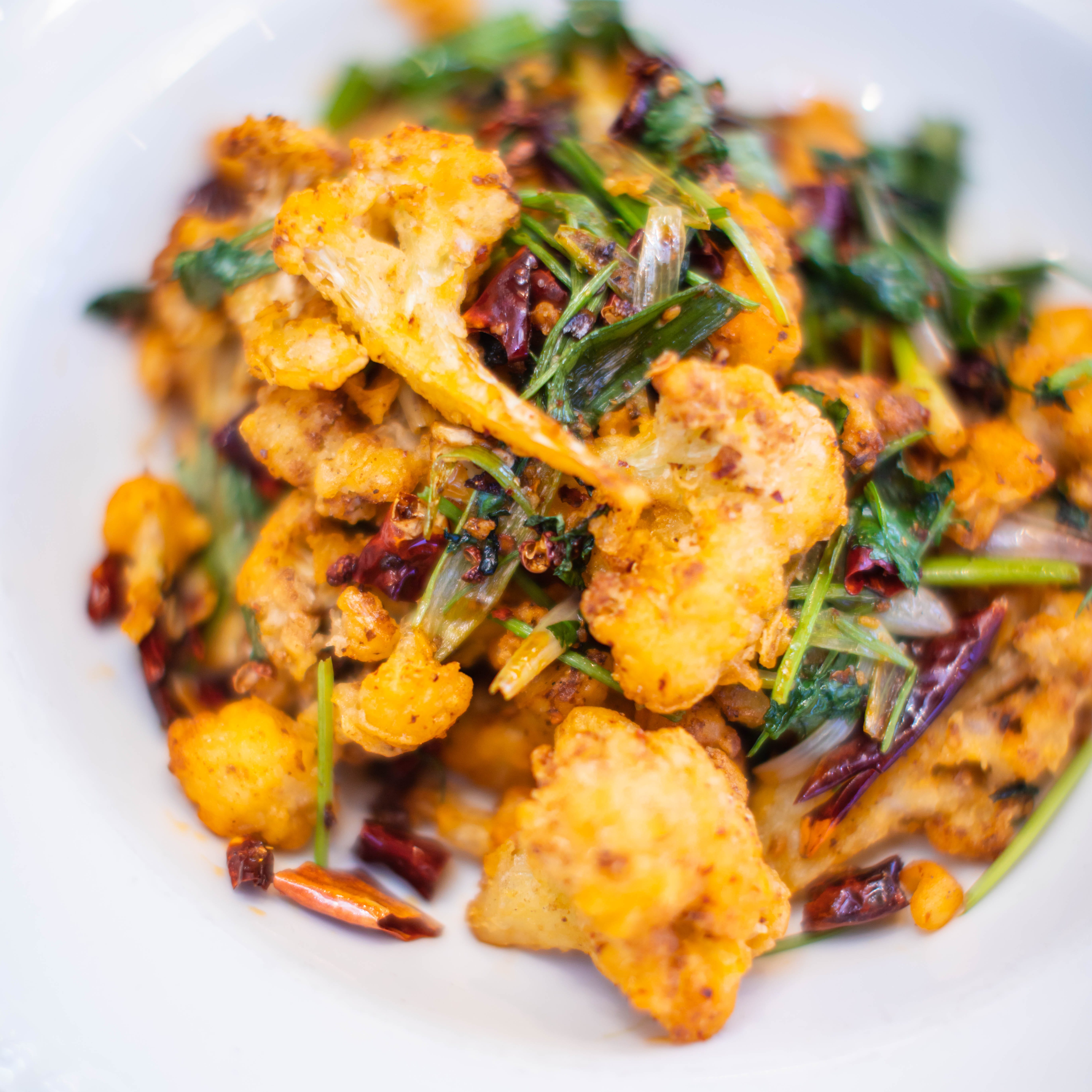
DUNLOP: Mmm. First dish has arrived.
T. COWEN: Our cauliflower is here. Lydia and Fuchsia, if you could speak to it, and also pass it around, and we can all start eating.
CHANG: Where we’re starting today is with the dry fried cauliflower, Tyler’s most favorite. Your family’s most favorite.
DUNLOP: Is it gan bian?
CHANG: Gan bian hua cai 干煸花菜.
DUNLOP: Yeah, gan bian is a particularly Sichuanese cooking method where you toss an ingredient in the dry wok without much on, and then you add oil and seasonings later.
CHANG: And you have the greeneries, too.
DUNLOP: Yeah.
CHANG: Cilantro, green onion with just a lot of seasonings. The flavors.
DUNLOP: And cauliflower has become so trendy in China in the last few years. For some reason —
[laughter]
CHANG: In the US as well.
DUNLOP: Really?
CHANG: Yes.
DUNLOP: Every Chinese restaurant.
STEFANIE GANS: Are they mashing it and grinding it and making it into mashed potatoes and rice there, too? It’s like a cauliflower crust, but as dough? Or just as a vegetable?
DUNLOP: Like this. There’s one dish that appears on practically every menu, you ji hua cai 有机花菜, which means organic cauliflower. I very much doubt that it’s all organic, but it’s always tossed with these spicy seasonings, or it’s sometimes served in a gan guo 干锅, like a black clay pot or an iron pot.
CHANG: The cooking is a little bit different. I think what they do in China is to do a stir-fry, or with maybe some source of protein, like ham or bacon. But our way of doing it — it’s lightly buttered, deep-fried first, and then we fry it in the wok again to add the seasonings.
PICHET ONG: And what’s amazing now is that if you actually shop in an Asian grocery store in the US, you’re going to see something that’s called Chinese cauliflower, which actually has less floret and more stem, the way Chinese like it.
DUNLOP: Yes. It’s looser, isn’t it? It’s a different vegetable.
ONG: It is. But ironically it’s not really a Chinese cauliflower, but it just so happens that it’s what we like.
DAVID HAGEDORN: Marketing, marketing.
ONG: I work in restaurants with a very heavy Asian accent, and so we embrace it fully and buy just those cauliflower. We have to drive out all the way, right, Seng?
SENG LUANGRATH: Mm-hmm [affirmative].
ONG: To get this cauliflower at Good Fortune or the Chinese supermarkets.
LUANGRATH: Yeah. I always ran into that, and I was like, “Why is it Chinese? I never heard of Chinese cauliflower.” So I guess someone’s just marketing the term using that, yeah.
T. COWEN: Now, Fuchsia, you and I — we did our last podcast about three years ago, I think, almost to the day. Since then, you’ve been back to China plenty. How has food in Chengdu changed, and in China more generally? Because three years is a long time in China. A lot happens, right?
DUNLOP: Yes.
T. COWEN: What are the differences?
DUNLOP: Well, I would say the craze for hot pot carries unabated. Hot pot and spicy skewers and —
T. COWEN: This is a negative to me. Am I wrong to think that? I like them, but they’re all a bit the same unless you go to a very, very good one.
DUNLOP: For me, it’s a negative. I think hot pot is really fun once in a while, but it’s sort of cook-your-own-dinner stuff, and it doesn’t really showcase the myriad of different cooking techniques. In a way, it’s just one narrow aspect of Chinese cuisine.
I think, if one looks at it cynically, the spread of hot pot is partly because it’s very cheap and easy for consumers, but also it’s very cheap and easy for restaurateurs because you don’t need skilled chefs. You need one master broth, and you need people to slice up a whole load of ingredients, and then you can make a lot of money.
And also some new ingredients. So okra and ice plant have popped up on menus everywhere. And also, this dish, actually. The cauliflower dish has become ubiquitous.

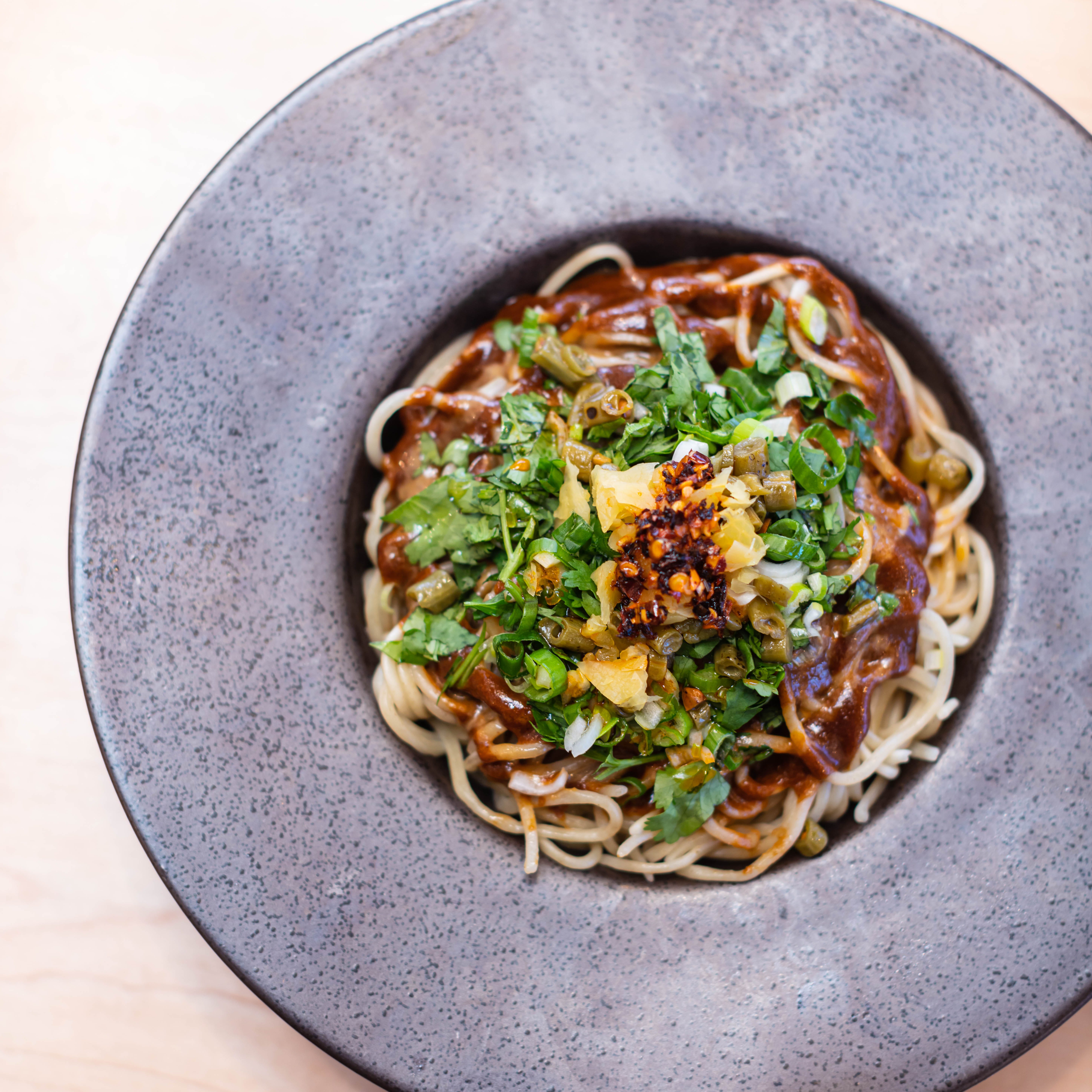
CHANG: What we’re coming up next is some Wuhan street snacks. Rè gān miàn, the Wuhan sesame noodles. and we have san xian doupi, the triple-layer doupi.
DUNLOP: This is really exciting.
CHANG: As per your request.
DUNLOP: Yeah, because I went to Wuhan in 1992 on my first trip to China, and I haven’t been back since. I remember tasting particularly the doupi. So the skin is . . . Talk me through the dish.
CHANG: It’s mung bean.
DUNLOP: So that’s the dou, the bean.
CHANG: Yeah.
DUNLOP: It’s bean skin, literally.
CHANG: Uh huh [affirmative]. With eggs.
DUNLOP: And it’s stuffed with fried rice, right? With little nuggets of —
CHANG: Sticky. Sticky rice.
DUNLOP: Ooh, exciting.
CHANG: The triple layer indicates one layer of the skin, one layer of the rice, and then also there’s a mince pork situation going on.
DUNLOP: I haven’t seen that dish anywhere since, so more than 20 years. And the rè gān miàn, hot dry noodles, is very famous, probably the most famous — with doupi — of Wuhan snacks, right?
CHANG: Yeah.
DUNLOP: And this is . . . Is it made with jian shui mian (碱水面)?
CHANG: We make our noodles here in-house. We couldn’t find the right consistency for the noodle. Again, this is not going to be as close as what we get in Wuhan, but because of the quality we have of noodles, we’re able to make them in-house.
DUNLOP: And this is with pickled beans —
CHANG: Yes.
DUNLOP: — or fresh beans?
CHANG: Yan jiang dou (腌豇豆).
DUNLOP: Yeah, so this is with salted yard-long beans. Mmm.
T. COWEN: Very good, isn’t it? Lydia, what would you say characterizes the food of Wuhan? If someone has never been to Wuhan, and you had to tell them on a postcard what it’s about?
CHANG: It’s a lot of fresh river fish. We are by the Yangtze River, so a lot of really fresh produce, river fish, and also the flavor. We don’t use Sichuan peppercorn. Sichuan peppercorn is from Sichuan, typically. But now I want to say the cuisine in China is so fluid and translucent, you can almost eat dumplings anywhere in the south, and you can eat Sichuan anywhere. The further north you go, you can eat Sichuan, too.
If we are really talking about the regional differences, we use a lot of local vegetables like hong shan cai tai (洪山菜苔). It’s something we haven’t had, or there’s no chance to eat outside of Wuhan, and that —
DUNLOP: Is that hong cai tai? The winter vegetable?
CHANG: Yes, yes.
DUNLOP: That is one of my favorite vegetables in the whole world. That’s red or purple rape shoots, right? And just in the winter. They are stir-fried, and they have a hint of bitterness, and they are juicy, and they are just marvelously delicious.
This doupi — to an English person, it’s reminding me a little bit of shepherd’s pie.
T. COWEN: Yeah.
DUNLOP: There’s a layer of sort of sauced pork.
FRIEDMAN: Sticky rice shepherd’s pie.
DUNLOP: And then sticky rice instead of potato, and the golden bean skin instead of maybe the layer of grated cheese and grill it on top.
T. COWEN: You learned Chinese food in China, of course, much of it in Sichuan province, Hunan province. As Chinese teach food, how is the method of education and training different from, say, Great Britain or the United States?
DUNLOP: Well, I haven’t been to culinary school in Great Britain or the United States, so I’m not sure.
T. COWEN: You’ve been to school in these countries.
DUNLOP: The first thing is that when you go to cooking school, you are learning the building blocks of a cuisine, which is like the grammar of a language. So the basic components, the basic processes and flavors, which you then put together to make a multitude of dishes.
Whereas, I guess, if you were studying French cuisine, you will learn some classic sauces, a bit of knife work, techniques of pastry making. In China, in Sichuan, absolutely fundamental was Dao Gong (刀工), the knife skills.
CHANG: I actually have a story to share about Dad’s cutting knife. He said when he first started learning, in school, there’s only limited time, but he wants to really excel at it. So he returned back to the dorm, started cutting, using cleaver to cut newspaper to practice.
DUNLOP: Really? [laughs]
CHANG: Yeah. There, they would spend a lot of time outside of school to be able to cut better, and it doesn’t matter what you cut as long as you are cutting as practice.
DUNLOP: Well, I remember, actually, my classmates at the cooking school. A lot of them were actually living in, and sometimes they would invite me up to the dormitories on our lunch break. And they would be practicing vegetable carving and dumpling shaping and so on.
When I enrolled at the school, I was given a cleaver and my chef’s whites, and that was the tools of the trade, really. Almost all the cutting — very sophisticated cutting — was done with this one knife, which is not a heavy butcher’s chopper, but the very light and versatile cutting cleaver.
RIVKA FRIEDMAN: I would love to know how you got into and fell in love with Chinese cuisine generally.
DUNLOP: Well, I was already a very enthusiastic eater and quite a serious cook from childhood. In my teens I was reading cookbooks and cooking, particularly French patisserie. I loved pastry-making in my teens.
Then I got into China through a job I had. Went there on holiday, loved it, started learning Mandarin. It wasn’t a plan. It looks like a plan in retrospect, but it really wasn’t. Ended up in the Sichuanese capital, Chengdu, as a British Council scholar. I was supposed to be doing academic work but ended up spending all my time in kitchens and then did some private classes at the cooking school. Finally, was invited to enroll as the first foreign student they’d had in a chef’s training course.
I had, since I was a teenager, been in the habit of keeping a diary, and the diary always ended up being recipes and menus and descriptions of food. That just carried on when I was in Sichuan. I was a scholarship student at the university, so didn’t have huge amounts of money to spend. But there were all these little, little shops and street stalls and little restaurants around the university, serving spectacular food, and it was all freshly made, dazzling flavors, healthy, delicious. So I was just curious about it.
I started not with some master plan to write books about Chinese food because, of course, it would have sounded insane for an Englishwoman to want to make a career out of writing about Chinese food in the ’90s. Insane. But it was just out of interest, and I got more and more interested as time went on.
YANA CHERNYAK: When you visited street stalls and all these small food shops, how willing were people to open their kitchens to you and show you behind the curtain?
DUNLOP: Surprisingly willing. Just to put that in context — in the ’90s, China was really just beginning to open up. So in Chengdu, this provincial capital city, there were only, I think, a couple of hundred foreigners. We were very novel and hugely interesting to local people, just as China was very interesting to us.
I would go to a restaurant owner and say, “May I study in your kitchen?” And people were just stunned that a foreigner and a woman and a university graduate student would actually like to be mingling with chefs and getting mucky in a kitchen. I think people just found it rather intriguing and hilarious.
I would go to a restaurant owner and say, “May I study in your kitchen?” And people were just stunned that a foreigner and a woman and a university graduate student would actually like to be mingling with chefs and getting mucky in a kitchen. I think people just found it rather intriguing and hilarious, and let me in.
And I always say this. All the work I’ve ever done is completely dependent on the generosity of people in China, and it’s very much a collaboration — people who have all this knowledge, but they don’t have the means to communicate in English, and they have always been very supportive and generous.

Coming up next, we have the salt and pepper lotus root sandwich (Jiao Yan Ou Jia), which, again, is a very typical Wuhan cuisine. We generally have this over Chinese New Year or at a big celebration. Something deep-fried is a luxury. Day to day, households don’t really do a large batch of oil and deep-fry, so that’s something we really considered as precious back then.
DUNLOP: So it’s like sandwiches.
CHANG: Yeah.
DUNLOP: Thin slices of lotus root with minced pork, is it, in the middle?
CHANG: Yes.
DUNLOP: And then coated in batter and deep-fried, right?
N. COWEN: I don’t know how well you know American Chinese food, like what you can find in America. I assume you do know it well. I wanted to find out, how is it different from what you can find in England? Is it basically the same scene, or is it a different scene?
DUNLOP: You have the old-school American Chinese food — chop suey, egg foo young — I would say were not as big in Britain. They were in the early days, but you don’t see them anymore.
I actually had my first American Chinese chop suey last year in Los Angeles. I went to this café in the Grand Central Market with Yu Bo, a famous Sichuanese chef, and I made him eat chop suey because I wanted to see his reaction.
[laughter]
T. COWEN: And?
DUNLOP: Well, he was very diplomatic and said that he thought it was quite a healthy and cheap meal.
[laughter]
DUNLOP: A mixture of meat and vegetables and rice and so on. But definitely light-years away from his own style of cooking.
So there are certain dishes that are really popular in America, in particular on the East Coast: General Tso’s chicken, which doesn’t really exist in England at all. Our traditional Chinese dishes were — when I was growing up, we had sweet and sour pork balls, a nugget of pork meat dipped in a very thick batter, deep-fried, and served with a bright, lurid red sauce, and this is what I adored as a child.
Then more recently, every Chinese restaurant, really — certainly in London, but I think nationwide — has crispy duck. It’s the easy way to do a Peking duck. Peking duck is very complicated. You need to wind-dry it. You use a special oven. But crispy duck — the duck is marinated and steamed and then deep-fried in pieces, so you can just order a quarter of a duck. But it’s served Peking duck–style with the very thin pancakes and the sweet fermented sauce and scallion and cucumber.
CHANG: It all sounded like a variety of fish and chips.
[laughter]
DUNLOP: Well, yeah. It’s just different, and it’s different communities and different markets and different evolution.
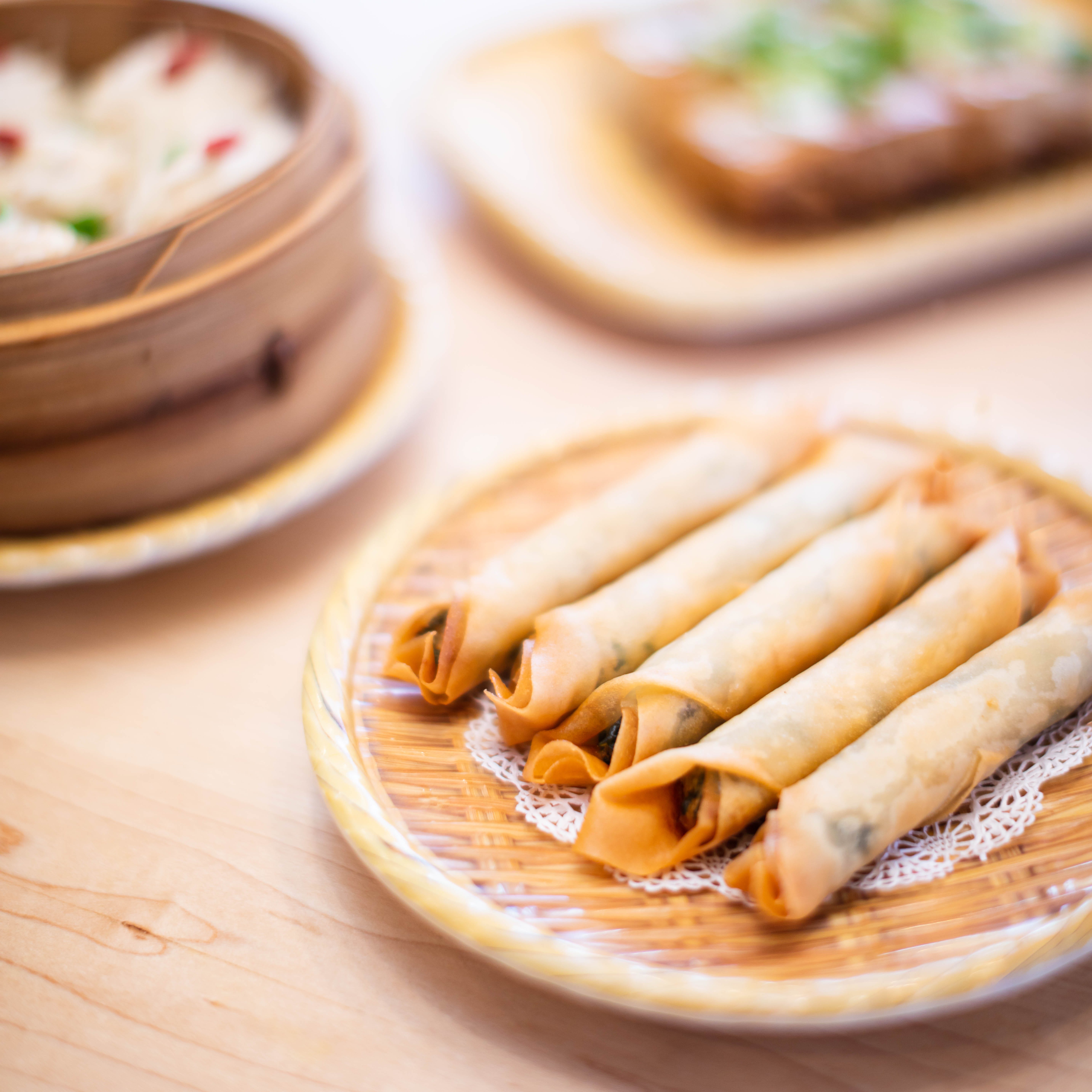
T. COWEN: And now we have, what? Coriander fish rolls? That’s a Peter Chang specialty, created by him. Am I wrong?
CHANG: Created by him.
T. COWEN: Tell us, is there a story?
CHANG: There is a lot of stories, and for the season right now, we incorporated blue Maryland crab. Today we’re taking it to a new version. You’re enjoying the crab roll. Fried cilantro crab roll.
CHANG: I actually have a question for Fuchsia. When you see the rise of Chinese cuisine . . . I think now the Chinese cuisine itself doesn’t have a boundary between the way they cook it in China and the way they cook it in the US, American Chinese cuisine versus the authentic Chinese cuisine. From my trips to China almost once every year, I noticed that food in China is slow to evolve, to change, as well.
When I was at a Shanghainese restaurant to have this drunken shrimp, I noticed that they use Sichuan peppercorn in the marinade. It comes to a wonderful surprise with the Shaoxing wine, the Sichuan peppercorn. There’s really no fine line between Cantonese cuisine, Shanghai cuisine, or Sichuan cuisine. Where do you think the future modern Chinese cuisine is going? It doesn’t have to be in China. I think it’s a global trend.
DUNLOP: Yeah, I think that a cuisine is always a living form of culture that’s recreated on a daily basis. It’s just not something static, and that’s where you trip up when you start getting hung up about notions of authenticity. Particularly in China, again, and Sichuan is a good example of a place with feverish competition in the restaurant business, and so many different restaurants, all chasing new ideas and new concepts.
There’s a period at the moment of extraordinary mixing, people traveling all over the world, all over China. As you said, you find Sichuanese dishes on everyone’s restaurant menus. Even the old Cantonese restaurants in London have to have some spicy dumplings or some spicy fish, because that’s what customers want.
And also in Sichuan itself, like the fish dish we’ve just had, that you find the duo jiao yu tou, the steamed fish head with chopped, salted chilies, which is very Hunanese, is popular in Sichuan. There are other dishes from Zhejiang.
But I don’t think this is actually something entirely new. When I was researching the new edition of the book, one thing that was really interesting was going back to the guide to Chengdu written in 1908, called the Chengdu Tong Lan (成都通览).
CHANG: Wow.
DUNLOP: This has a list of restaurants and dishes and snacks, and you can see from that period that it was already quite cosmopolitan, and there were quite a few dishes that were clearly from the Jiangnan region. There were Western dishes, like certain pork chops and dishes with curry, which would have come, I think, from the . . . There were foreign missionaries living in Chengdu in early 20th century.
In the 20th century, there was a period when China closed in on itself. We’re now just having another period of flowering, but with increased transport links, of course, it’s faster and crazier and more international.
But I think you’re right that the big difference with Chinese food in the West is that you no longer have a community of mainly Cantonese American Chinese people who are catering for Western tastes and who don’t have access to many local ingredients apart from dried and preserved food, which they could import very early on.
You now have a fluid interaction between food in China and food in Chinese communities abroad. And many of the customers, as you’ve said here, are actually Chinese, and they’re recent arrivals or temporary residents in the States, and they don’t want to eat Americanized Chinese food. They want to eat the same food they have at home.
Then also, I think in California, there are people growing Chinese vegetables. There’s fresh produce air-freighted in. So it’s not just soy sauce and dried shrimp and things that you can get to make Chinese food. You can get so many ingredients.
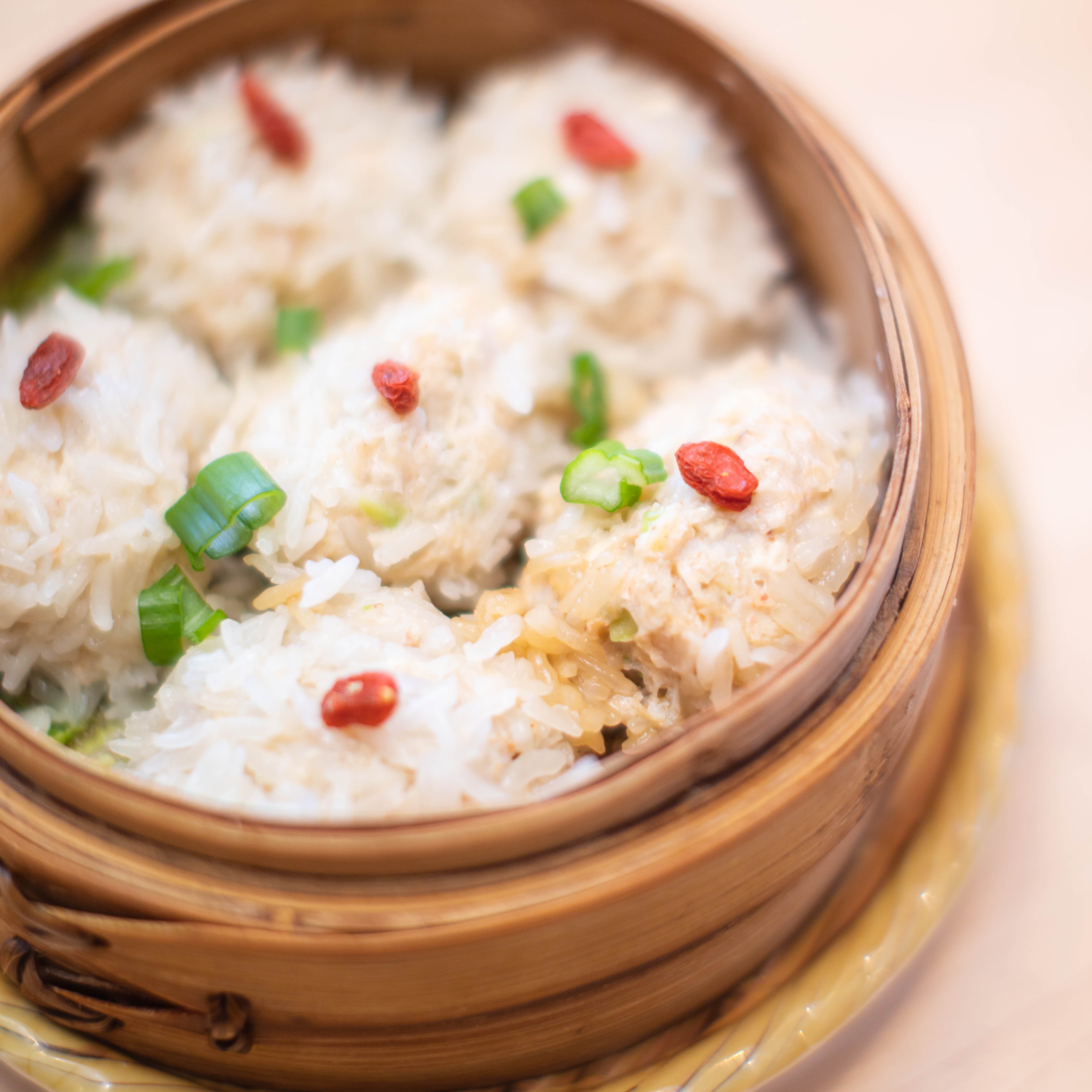
T. COWEN: Lydia, the new dish?
CHANG: Yes. We have Grandma’s sticky rice bowl with crab. Typically, the filling varies. Traditionally with minced pork. Pork is heavily used in central east China. But again, because of crabs in season right now . . . It’s about where you are. The food changes.
DUNLOP: So is it just crab, or is it crab mixed with pork?
CHANG: Crab mixed with tofu.
DUNLOP: Oh, really?
CHANG: Yes.
DUNLOP: How interesting. And they look very pretty, all speckled with rice grains, don’t they, on the outside?
DAVID HAGEDORN: Lydia’s father is of a generation who, in China, lived through the Great Famine. Indeed, it wasn’t until he went to cooking school as a young man that he was exposed to food in abundance. There were many things he had never tasted before because the farm they came from in the country — it was such deprivation. How has that experience for so many chefs of this generation informed the cooking of China?
DUNLOP: Well, I suppose everyone of that generation had experience of acute hardship of different degrees, depending on where you were living.
One of the great joys of the reform period has been the easy availability of food, and particularly of meat because people who lived through those years told me that they used to dream and fantasize about pork because they never had it. Some people used to, for example, have a small piece of fatty pork and use it to wipe around the wok for stir-frying vegetables and keep it for the next dish because they really didn’t have enough meat to eat.
I think that sometimes the excess of Chinese dining out, with tables laden with dishes, which is something the Chinese government is actually trying to curb now — there’s a campaign to make people waste less food and eat what’s on the table — but that’s a reaction to the period of deprivation.
One thing that really amazes me is how, despite these very tough years — and not only the famine, but also the Cultural Revolution, which was an assault on bourgeois and elite culture, when fancy food and elegant restaurants were attacked and forced to change their ways and become more proletarian — that it’s extraordinary that the cuisine has recovered and that you can once again get exquisite and refined Chinese food.
I was talking to one elderly chef recently about the Cultural Revolution period, and I was asking him about the effect of the movement on the dishes they were allowed to cook. And he said, “Well, actually, that was the least of our problems. The main problem was there just wasn’t enough of everything.”
Given that China is a particularly food-focused culture and it’s always been so important, I think, yeah, the memory of deprivation is very strong for the elder generation. But of course, not for the younger generation, right? So you don’t have direct experience of this, do you, Lydia?
CHANG: Lucky me.
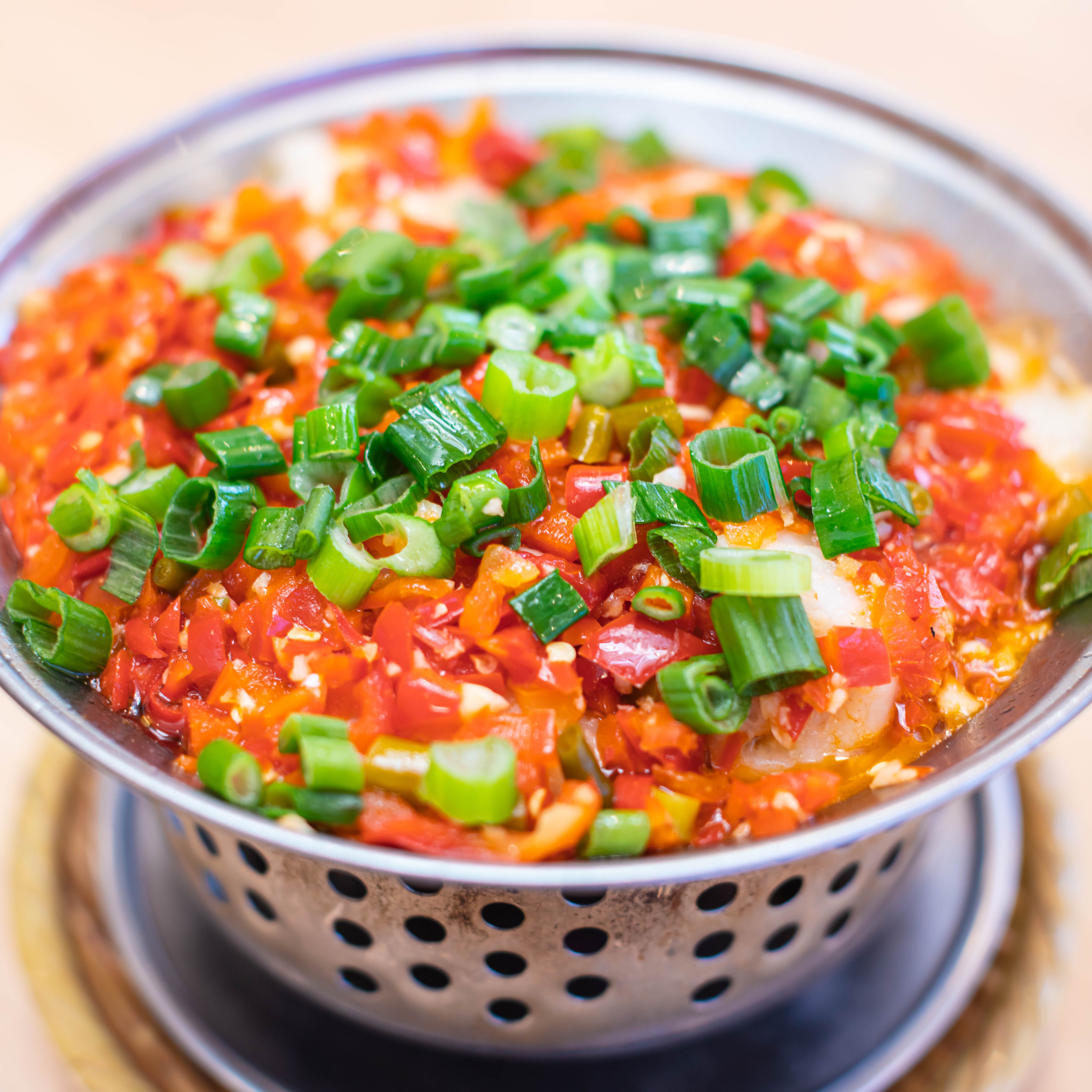
DUNLOP: What’s your most popular dish with Chinese guests and with non-Chinese guests here?
CHANG: Now it’s all infused. We get a lot of reviews, luckily, from the Washington Post, the Washingtonian. And people have the urge to try something different. They want to know more about why the food is cooked this way.
Of course, they’re going to get their favorite Gong bao chicken, the Mapo Tofu. But also, when you see this fish dish with piles of chopped fresh chilies, how can you resist? This is the dish that’s very popular on the menu. The fresh chili flounder fish with vermicelli.
DUNLOP: Mmm, that’s a bit like a Hunanese duo jiao yu tou.
CHANG: Yeah, exactly.
DUNLOP: In Hunan, a very popular dish is the head of the giant carp, big-head carp, split in two on a huge platter and covered in pickled chilies and steamed. This is a smaller version of that with flounder.
ONG: I remember the first time I actually experienced Sichuan peppercorn was in the ’90s. I have a very different background of being Chinese because my parents left China during the war in the late ’30s and early ’40s, and I was born in Thailand and grew up in Singapore. I don’t have any Sichuanese in my blood.
But it’s really strange that the first time I actually encountered the taste was through Japanese cooking with sansho pepper. In Japanese cuisine, sansho pepper is actually like Chinese peppers. And because, perhaps, the Japanese palate likes more subtle flavor, it’s always brined or soaked in water or sugar water. Is that correct? Then it’s a very different effect because it has a very gentle numbing effect, which is the main characteristic of Sichuan peppercorn.
So in the ’90s, it was a big shock for me, and it actually took me a whole decade to become accustomed to that heady, spicy sensation that lasts for a long time, actually, beyond chilies.
DUNLOP: Yes, you’re right. There are many different varieties of the plant. The classic red Sichuan pepper — there are actually different varieties from different parts of China, and it’s thought to express its terroir, like wine grapes. Some boutique Sichuan pepper producers now are starting to label the exact place of origin of their pepper, and you can really taste the difference.
But there’s also green Sichuan pepper, which has appeared on the market only since the late ’90s. That was a previously wild variety that was then licensed as a food in the late ’90s and is everywhere now. It has a very zesty, refreshing lime flavor, and it’s particularly good with fish, with frog, in light, vibrant, soupy dishes.
T. COWEN: And this will also take over the world, in my opinion.
DUNLOP: It will take over the world, yeah.
[laughter]
DUNLOP: And sansho is another variety. In the countryside in China, I’ve stayed in farmhouses where people use wild varieties of Sichuan pepper, and they add them to their green tea, for example.
T. COWEN: How is Chinese or Sichuan farmhouse cooking different from, say, the urban styles a tourist would more likely encounter? Is it more fermentation or what else?
DUNLOP: Well, I think city people would often say that country cooking tastes the best, because you get, often, people growing their own vegetables.
T. COWEN: Right. But is it otherwise different, other than just freshness?
DUNLOP: You have, I would say, less meat, generally, because people traditionally would rear their own pigs for meat. And fabulous cured pork, so bacon and sausages which will be used, and salt pork, used in small amounts and cooked with country vegetables.
And sometimes more coarse vegetables, like potatoes and sweet corn and so on. And also wild vegetables, so a certain amount of foraged greens, for example. And pickles, yes. Traditionally, everyone would have a pickle jar, and they would use pickles to add umami flavors and refreshing sourness to their dishes.
T. COWEN: I have the most naïve question possible. As an economist, I’m interested in the geographic spread of innovation. Ma la I find to be one of the glories of cooking anywhere, the whole world.
But why has ma la not spread to more locales, either within China or elsewhere? What hinders the spread of ma la? And if you look at the border condition — well, there’s ma la here, but not there. What accounts for that? Do you have any sense of that, Fuchsia?
DUNLOP: Well, firstly, it’s just concerned with patterns of immigration. So the ma taste, the tingly taste — and that’s the word in Chinese which also means pins and needles and anesthesia, the tingly taste of Sichuan pepper — that ma flavor is very particular to Sichuan. Sichuan is an inland province and did not send people out into the world en masse until comparatively recently.
T. COWEN: But I cook with it. Why don’t the people, say, in Wuhan, or some other part of China?
DUNLOP: I think now they do.
CHANG: Now they do.
DUNLOP: Since the reform and opening up in the ’90s, there are Sichuan restaurants all over the country, and people are crazy for ma la. But I think one of the reasons is that it’s so stimulating, and people now — particularly in cities — they have such a dizzying choice of different foods they can eat, and ma la is a flavor that holds its own in a very crowded marketplace.
Also, some more delicate cuisines — they speak more quietly, and they don’t attract your attention in the same way. I think they get drowned out, like the delicate cooking of the Jiangnan region around Shanghai, which we were talking about the last time. But that’s more subtle, more difficult to do well, relies more on particular ingredients. Sichuanese ma la flavor is this flavor bomb you can apply to anything. So you’re right. It travels very well.
But your question about why it’s not more pervasive — it’s just because it’s early days. It’s going to be everywhere.
T. COWEN: So it will take over the world.
DUNLOP: It will.
HAGEDORN: Lydia’s mother has a good story about Sichuan peppercorn.
CHANG: When she first encountered Sichuan peppercorn, she’s like . . . She’s very adventurous.
T. COWEN: Where’s she from in China?
CHANG: Wuhan.
T. COWEN: Okay, Wuhan.
CHANG: Like Fuchsia said, we didn’t know what the ingredient is until in the ’90s, and that’s when Mom started to discover this new sensation. She’s the first one in her family to step out of the comfort zone, be like, “Oh, this is really interesting. Let me see what I can do with it.” So nowadays, she even uses Sichuan peppercorn in her cookies.
[laughter]
CHANG: That’s how crazy she is.

CHANG: So for example, the soup we’re drinking right now — it’s black bone chicken soup, Wu Ji Tang乌鸡汤. Typically, you would see the spice that we use, Gan Liao 干料, to make the soup, Da Liao 大料. But the version that we make now — it’s very clear. It’s like how my mom likes to drink.
DUNLOP: Isn’t that dāngguī in there?
CHANG: Yeah.
DUNLOP: Chinese angelica.
CHANG: Yes.
DUNLOP: That slightly astringent taste there.
CHANG: Uh-huh.
GANS: What is that?
DUNLOP: It’s a medicinal herb, Chinese angelica. Dāngguī.
CHANG: There’s also Chinese dates. You see the red goji berry. And then the Chinese yam.
DUNLOP: Yeah, the Chinese yam, which has a lovely consistency. A bit like potato, but a bit slippery as well.
But I particularly asked Lydia for this soup because, for one thing, I thought it would be nice to have a very refreshing, palate-cleansing contrast to some of the spicier dishes. And also because soup is so important in Chinese meals. Almost every Chinese meal will have some sort of soup, even if it’s really rudimentary. Just Mi Tang 米汤 in the countryside, which is the leftover water used for parboiling rice. Or you might just have some pumpkin boiled in water, and it’s a palate cleanser.
That’s one real difference, I think, between Western and Chinese cuisines, that soup is more necessary for Chinese people as part of the diet.
CHANG: I agree.
DUNLOP: If I’m cooking for friends at home, if they’re not Chinese, I might make a soup or not. But if I’m cooking for Chinese friends, I would put a lot of effort into making a beautiful broth because they’ll really appreciate it, and it’ll make them enjoy the whole meal more as well.
T. COWEN: What does China do best in Western food?
ONG: Pastry.
[laughter]
DUNLOP: Actually, you’re right. You’re quite right.
ONG: Pastry.
DUNLOP: Yes.
ONG: And it’s actually the greatest love affair for a Chinese person. As you were mentioning, the cosmopolitan cities with the people of expats and the locals . . . The idea of pastry from all over the world has really penetrated China with a very — kind of synergy.
DUNLOP: Yeah, you’ve absolutely nailed it.
ONG: Lamination bread, steamed, baked. And it’s really taken onto a next level. In Taiwan in particular, bread is just infused with local ingredients like Long An 龙眼or local wine, tea. I think that that’s the greatest marriage of technique and ideas.
DUNLOP: In China, one thing that’s quite trendy is toast, so you get toast cafés.
ONG: Right.
DUNLOP: But this is not toast as English people like it, sort of crusty toast with butter and jam.
ONG: Or anywhere, really.
DUNLOP: Yeah. And they have these very soft, square loaves, which are served with all kinds of different toppings. Sometimes ham and cheese and ketchup, or sometimes the bread is mixed up with red beans. So it’s a totally fusion food. You also get pizzas that would outrage any Italian, like durian pizza.
ONG: Right.
DUNLOP: Lychee pizza.
ONG: Yes.
DUNLOP: Strawberry and chocolate pizza.
But also, in Chengdu, and this is one thing — the French patisserie — I had some of the best croissants that I’ve had anywhere in Chengdu recently, made by a young Sichuanese pastry chef who’s married to a Frenchman and lived in Paris and trained in Paris.
There are several patisseries in Chengdu, and these are not fusion creations that would horrify Italians like the pizzas. They are doing patisserie, but with Chinese ingredients, sometimes a bit less sweet because Chinese tend not to like the sweetness of, say, Americans or even French. But done with stunningly beautiful technique. Absolutely ravishing displays of pastries. You just want to eat everything.
ONG: I agree, and I was surprised because I’ve been traveling to China since the ’90s as well, and I see the change. Cities or towns that weren’t popular back then, like Xi’an. I managed to find really top-notch croissants.
DUNLOP: Yes. The thing that’s really remarkable about that is the speed, because it’s happened in five years, ten years?
ONG: Correct.
DUNLOP: Not more than that. It’s just like lightning. Suddenly they’ve cracked patisserie, in the way that the Japanese have.
DUNLOP: One thing also that’s really, really shocking to me, for a great tea-drinking nation, is the popularity of coffee. Not only Starbucks, which has spread like a rash over the whole country and now has a local imitator called Luckin Coffee —
ONG: Correct.
DUNLOP: — which emerged from nowhere. But also, there are so many little cafés doing freshly ground coffee beans.
I went to a little town near Leshan, where the Giant Buddha is, in pursuit of this particular fermented tofu, which I adore. I was dying for an espresso, and I thought, no hope in this little country town. But I found a little café, and I had a superb espresso made with freshly ground beans. Absolutely amazing. But the only thing was, they served it with a little dish of ma la pickled radish, which is a really unpleasant flavor combination, in my opinion.
[laughter]
FRIEDMAN: Where would you go in China if you were somebody who restricted meat? I’m also curious from a home-cooking perspective how you’d make a good meal without meat.
DUNLOP: If you want to make a good meal without meat, then Chinese cuisine offers plenty of fabulous solutions because the Chinese are brilliant at using fermented foods like soy sauce, black beans, Sichuan chili bean paste, and fermented tofu, all of which have almost meaty or cheesy or creamy umami flavors, to cook with vegetables. So you can make the kind of dishes that are actually very appealing and satisfying to meat eaters as well as vegetarians because of these very bold and satisfying flavors and mouthfeels.
But vegetarians in China do have a bit of a problem, and that is because the Chinese approach to vegetarian eating is very different from the Western approach. So in China, people often make a distinction between Chinese Su Shi 素食, vegetarian eating, vegetarian food, and Su Shi Zhu Yi 素食主义, vegetarianism. Many Chinese people believe in Buddhism and will have vegetarian food when they go to visit a temple or on certain holy days, but they don’t abstain from meat all the time. I’ve even met an elderly monk who was a lifelong vegetarian who said that when he was sick or weak, he would eat a little meat to boost his strength.
So vegetarians traveling around China have this problem, that sometimes they ask for vegetarian food, and it has little bits of meat in it, or it’s cooked with lard or stock or dried shrimps. It’s quite hard. You have to really insist to restaurants that “I am a total vegetarian. I don’t . . .” You have to list the things you don’t want, to explain.
The only place that traditionally you would get pure vegetarian and even vegan food is in Buddhist monasteries, and sometimes Taoist monasteries. The larger ones have their own restaurants which cater for pilgrims and patrons and do extraordinary vegetarian cuisine. So partly it’s simple vegetarian cooking, and partly it’s Fang Hun Cai 仿荤菜, imitation meat dishes. Impossible Burger, they got there centuries before you! So you can go in Sichuan to a monastery, and you can feast on spare ribs and shark’s fin and sausages and gong bao chicken, and they’re all totally vegetarian.
One change in the last few years is that there are a small number of Chinese people, maybe cosmopolitan, intellectual types in cities, who are becoming vegetarians in that Western way. It is, actually, often connected with Buddhism, but they are abstaining totally from meat, and not only from meat, but also from Wu Hun 五荤, the pungent aromatics like garlic and all kinds of oniony vegetables, which is also part of the Buddhist diet.
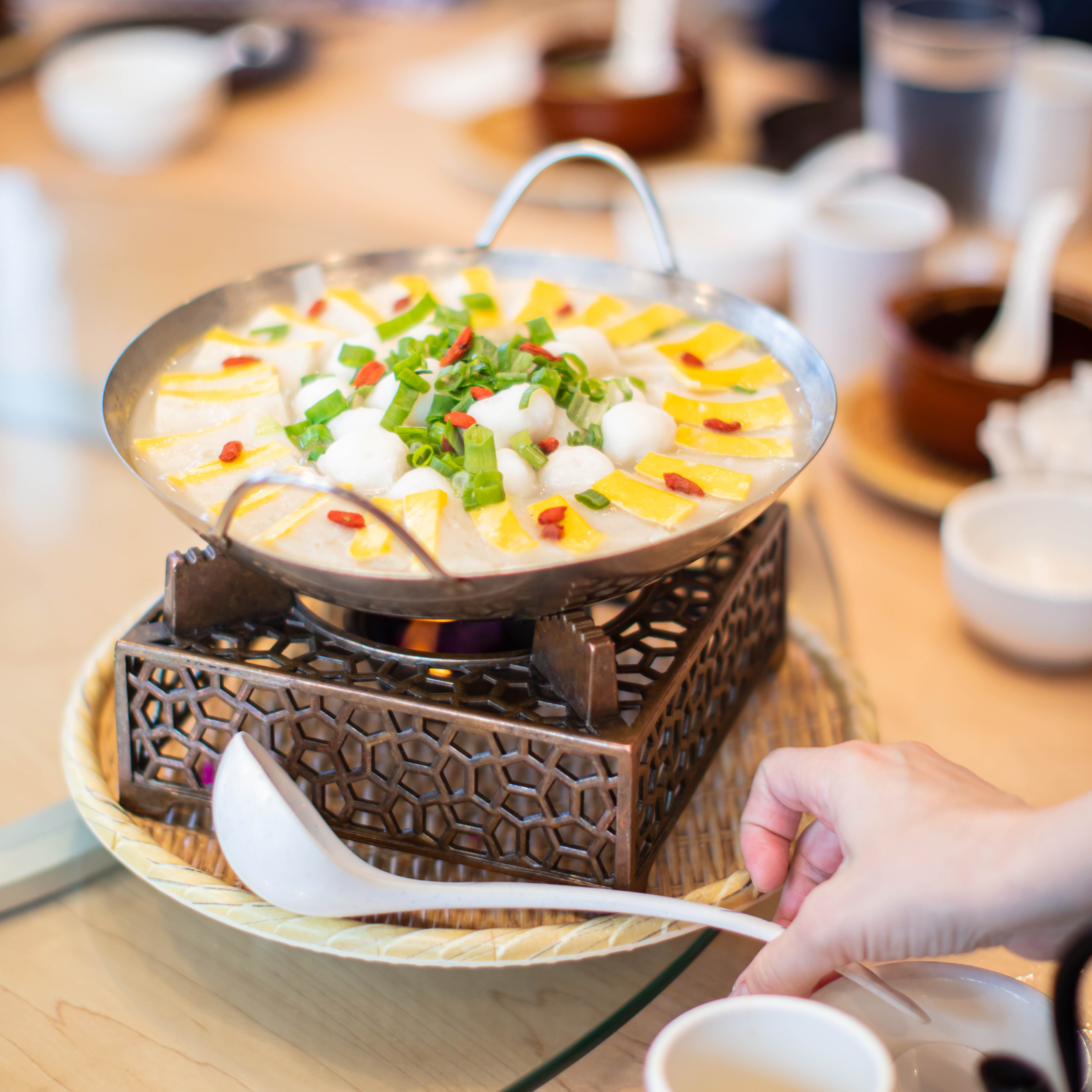
COWEN: Lydia, the next dish, if you could, please.
CHANG: Yes. What we have here — it’s a Jingzhou-style fish cake with a yellow, eggy skin, with Grandmother’s fish balls. Again, this is the dish that’s loved by our Western and Chinese clients.
DUNLOP: That’s so pretty.
CHANG: Yeah. Everything in here is made in-house. That’s years of culinary experience.
DUNLOP: Yeah. And that’s very classical presentation.
CHANG: Precisely.
DUNLOP: With all these carefully cut rectangles of egg skin. And you don’t actually often see that.
CHANG: No.
DUNLOP: Not even in China. And this fish ball dish reminds me of a lot of New Year dishes in many regions of China, which are quite laborious to make because separately, you’ve made a fish cake and fish balls and then cut them up and reheated them in a big festive pot. People would often do that sort of thing for the Chinese New Year.
GANS: Lao Gan Ma, spicy chili crisp.
DUNLOP: Yes, that’s delicious. Yes.
GANS: Is that a here thing or a there thing? It’s everywhere. The whole world.
DUNLOP: Oh, it’s very trendy, and it’s from Guizhou province, another spice-eating province in southwest China. It was invented by a woman, Lao Gan Ma, and it’s now . . . There’s mass production, and it has been popular in China for a long time.
And now Westerners are getting addicted. But it’s quite funny. When you take a flight on Sichuan Airlines, they have pretty good food and Sichuanese dishes, maybe with rice. And the steward will go around with a jar of Lao Gan Ma sauce —
GANS: Wow.
DUNLOP: And offer to put a spoonful on your food for extra heat.
GANS: What airline is that?
DUNLOP: Sichuan Airlines.

T. COWEN: Lydia, the next dish if you please.
CHANG: The red pepper chicken with sesame. Again, that’s our version of the Chongqing chicken. We want to make something a little lighter, not so heavily battered. And the sesame flavor just creates a balance of the red peppers.
FRIEDMAN: I have a question. What are some of the most interesting economic, historic determinants of food?
For example, in the north of Italy, it was typically a wealthier region, so the pasta dishes come from a lot of 00 flour, whereas in the south, semolina is more popular, and that’s really shaped the food scene.
What are some of your favorite stories from China of the ways in which those economic realities or just technological realities have shaped the direction of food development?
DUNLOP: Well, I suppose the first thing is that patterns of trade historically… One thing that I always find very fascinating is that many Chinese ingredients bear the names of the era and the place from which they were imported.
So for example, pepper in Chinese is called hújiāo, barbarian pepper, because it was an imported pepper from the northwest where the hú, barbarians, lived. From the Han dynasty onwards into China, jiāo, pepper, was the original Sichuan pepper. So lots of imports. From that, you can tell from the name that they came from the northwest in that period.
And there are other ones, like the ingredients that came from the sea during the Ming dynasty and the early Qing bear the name fān, which is another word for barbarian. So the tomato is called fānqié, which means a barbarian eggplant. And one of the early names for chili was fānjiāo, barbarian pepper. In Sichuan, they still call it hǎijiāo, sea pepper.
In terms of connection with economics, it’s very conspicuous that the great Chinese cuisines have always followed the money. So you had a flourishing restaurant scene in Kaifeng, the city now known as Kaifeng, which was the northern Song dynasty capital for about the 10th century. And there were restaurants, including Sichuanese restaurants, at that time in Kaifeng.
When the Song dynasty was overrun by nomadic barbarians in about, I think, the 13th century, the capital fled south to Hangzhou. Then you had the court and so on in Hangzhou, and that became a flourishing cultural center. That’s where you also have an extraordinary cuisine, food writing, poetry about food, restaurants.
The Jiangnan region — that sort of Hangzhou and Yangzhou — all these cities were the crux of trade paths, and for the salt trade, where it all went through Yangzhou. There were lots of rich salt merchants, and they were the people who were having lavish dinner parties, entertaining the Qianlong emperor on his southern tours. And many of the grand old dishes come from there.
Later, you have Shanghai and Ningbo, and these areas becoming rich treaty ports and having a different sort of cuisine. In Shanghai, an early fusion cuisine with . . . There were Western restaurants in Shanghai dating back to about 1900, doing a Shanghainese version of Western food.
Then during the Cultural Revolution and so on, the place where you had all the Chinese money and the elite — Taiwan and Hong Kong and those places — became the custodians of traditional gastronomy.
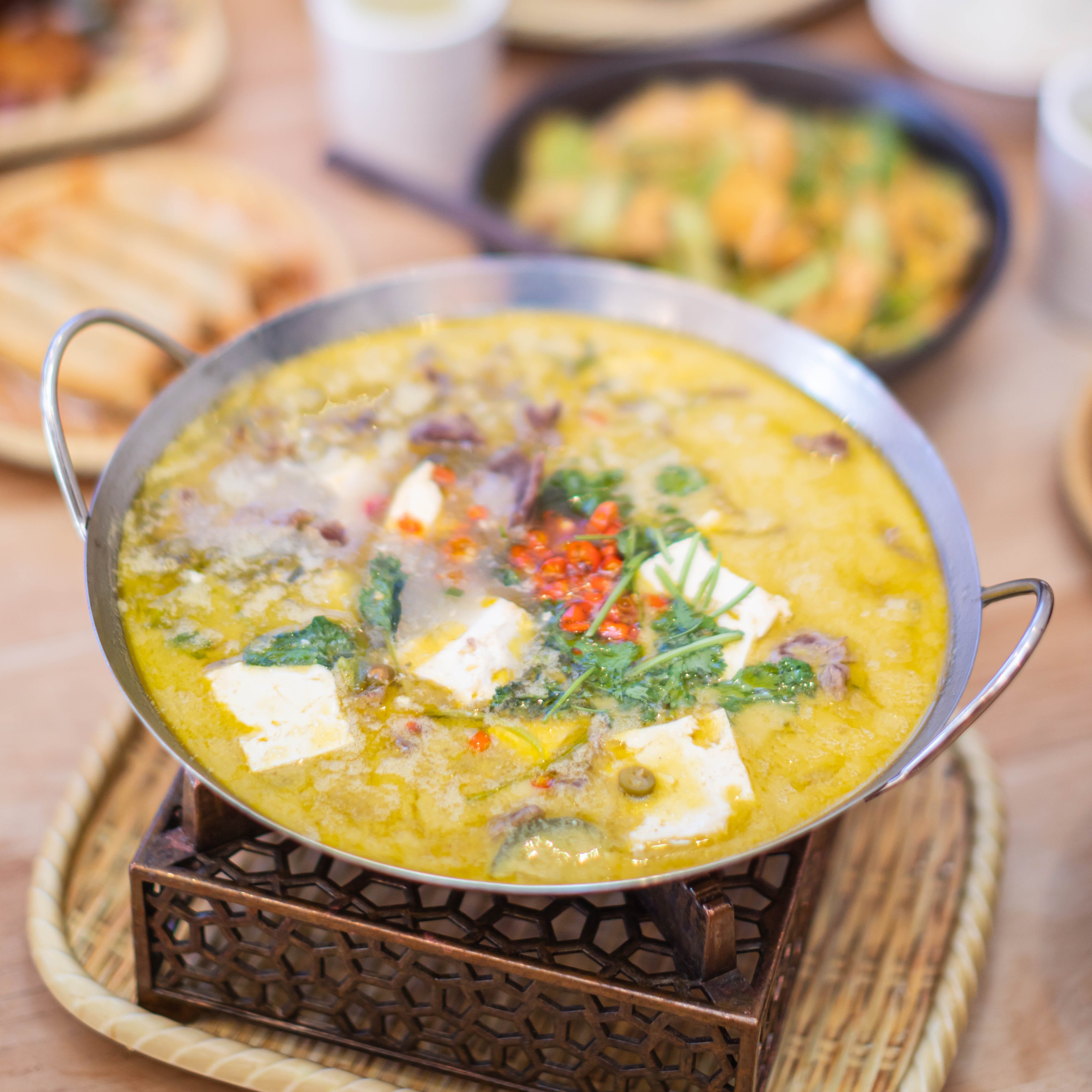
CHANG: All right, for those who’ve been anticipating the spice, the Mama Chang home style is not really too focused on just the heat, the spicy, but actually a lot of balanced flavors. So far, we didn’t really have something that’s too intense.
However, this one — we call it Guo Jiang Niu 过江牛, Yangtze River beef, [laughs] because of where we are from in Wuhan City. We are by the Yangtze River. So the main spice we use in here is actually pickled chili with some bird’s eye chili and pickled chilies.
DUNLOP: And those are the really deadly little green —
CHANG: Yeah.
DUNLOP: Yeah, Ye Shan Jiao 野山椒. They’re called wild mountain chilies. You look at that, and it’s a delicate jade green. It doesn’t look really red and spicy.
CHANG: Right.
DUNLOP: But they’re the hottest sort of pickled chilies. And also, the bird’s eye, little rice chilies. In Chinese, Xiao Mi Jiao 小米椒.
LUANGRATH: I think I have that version with fish, the flounder.
DUNLOP: Yeah?
LUANGRATH: Yeah. I remember having that. I was really surprised how Sichuan use the pickled chili.
CHANG: Yeah.
LUANGRATH: That was my first time, here, actually here. And I was just — can’t stop eating it.
CHANG: Again, that’s kind of our way of incorporating what we can find here in the United States, so we use a lot of Thai chili with the pickled chilies.
T. COWEN: [to Chef Luangrath] Now, you’re a famous Laotian cook. When you encounter Sichuan food and also from Wuhan, what connections strike you, or what differences? You must see this all through a different lens than we do.
LUANGRATH: Yeah. I remember having encountered Sichuan cuisine actually through Peter Chang, because I remember when I first moved here, I actually went to my friend’s house, who is from northern Laos, and she was making this chili paste. It’s a dry chili paste with northern Laos peppercorn. It’s very similar to Sichuan peppercorn, but it’s milder flavor. And I was encounter it the first time. I took the first bite. I was like, “What is this? How come I never experienced this in my life before? And it’s from Laos!”
I actually did a lot of research, and I found Peter Chang. Actually was thinking about driving all the way to Williamsburg to try that, but I didn’t make it out there until Peter Chang was opening here.
Ever since then, I just start to experiment more with Sichuan peppercorn infused with Laotian cooking. I actually made a dish recently with steamed chicken with Sichuan peppercorn. It’s like a chili paste with a little bit of oil, because I pretty much do a lot of Sichuan peppercorn cuisine as well. We don’t use oil when we make chili paste. So I start to infuse that with oil and use that on the chicken.
DUNLOP: Yeah. In Laotian food, do you — because I don’t really know about Laotian food — but do you have that sweet, sour, spicy, salty thing going on?
LUANGRATH: No, mostly savory and sour, spicy, and a little bit complex. I would say complex because of a lot of different herbs that we use.
HAGEDORN: And some funky.
LUANGRATH: Definitely funky. I forgot that one. [laughs] Definitely funky. We use a lot of fish paste.
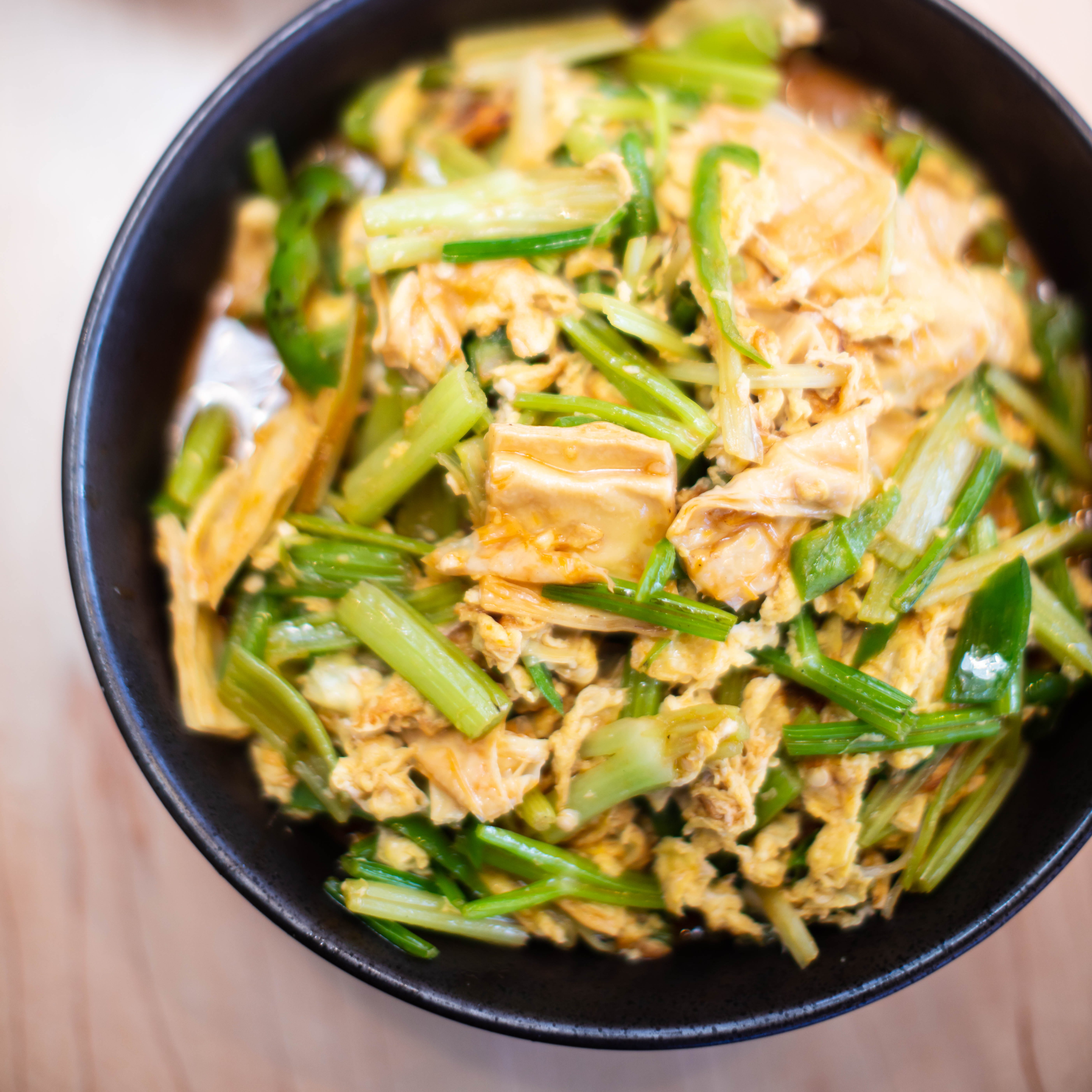
DUNLOP: Is this very different from your other restaurants?
CHANG: Yes.
T. COWEN: Explain that a bit.
CHANG: We wanted to do more home-style cooking. My family spent most time in Wuhan besides our time in the US right now.
For example, the fish cake. It originated from one of the Gu Cheng Jing Zhou 古城荆州. It’s a very typical fish cake in that region. I typically don’t really see this kind of fish cake outside of Hubei province. This is something that takes a lot of skill, and people outside of the region would have a different variety of fish cake. But the way to make an eggy skin — that’s something very typical in Hubei.
So our main focus here is really to launch what we like to eat at home. For example, the veggie dish, for vegetarians who eat eggs, a farmer’s stir-fry. It’s a stir-fry of some green peppers, Chinese celery, tofu skin, and eggs. This is something my grandma can easily make out of the ingredients she can get from her garden. Sometimes it’s tofu skin. Sometimes it’s just homemade tofu.
DUNLOP: I think it’s so interesting because, certainly, when I started writing about Chinese food, I was reviewing Chinese restaurants in London for Time Out magazine.
A lot of the Chinese restaurants of that period — they had the English-language menu intended for English speakers, and they would have secret Chinese menus with all the really good and interesting dishes that the Chinese people wanted to eat. I mean, not strictly segregated, but a lot of the funkier dishes or the more unusual ones and I think —
CHANG: That you don’t find translation to.
DUNLOP: Yes, and I think that a lot of Westerners used to go to Chinese restaurants with a very fixed idea about what Chinese food was, and they would want those classic, familiar dishes. And that’s totally changed. Now you can put anything on a Chinese menu, and the foodie people, the more adventurous people, are keen to try new dishes, right? So you don’t have to cater for different audiences anymore.
CHANG: No, we don’t. And sometimes we do find our non-Chinese customers are more open to trying new things because the Chinese normally come having this same menu over and over.
DUNLOP: That’s really funny. It’s like it’s the other way around.
CHANG: Yeah.
HAGEDORN: I have a writing question because I write cookbooks for other chefs. You’ve updated this cookbook. I like to explain to people that there’s fashion in cooking, just like there’s fashion in anything else, and they age and they grow and they reference the past.
But also in writing styles, too, there’s a fashion. How has the writing world and the writing style changed now compared to when you set out to write this?
DUNLOP: Well, I think there’s a huge appetite for detailed cultural information about food. When I sent a proposal for my first Sichuan cookbook in the late ’90s, it was rejected by all six publishers. They all said that, well, British readers would not be interested in a regional Chinese cookbook because it was too niche and too narrow.
I think you can see how ridiculous that statement sounds now, because I think there’s a real hunger for specific and specialized cookbooks. So that’s completely changed. It’s not an outlying thing to want to do a very local and regional cookbook.
And I think there’s been an explosion in food writing as a genre, not just in books, but on the internet and all kinds of new, indie food magazines, and an appetite for more stories about food. So that’s just become very mainstream.
But I would say that the main difference that . . . Well, one is the greater availability of ingredients and the hunger for authentic information. But also, just in design and people wanting lots of photographs and visual information as well.
HAGEDORN: And has the way you approach writing recipes now — has that changed over the years?
DUNLOP: No, I don’t think so. I’m more experienced, so I think it’s a bit more streamlined. But I would say that it’s possible to push the boat out a bit further in terms of more adventurous dishes and ingredients. Because I always want to have the majority of dishes in a cookbook doable for someone.
T. COWEN: But not all of them. So every now and then, you sit back, and you cackle, “I’m going to put one in that none of them can make.”
DUNLOP: Yeah, being ahead of the curve.
T. COWEN: Which recipe would that be in your new book?
DUNLOP: Well, there’s a very popular, very fiery Chongqing dish called mao xue wang, which is spicy blood stew, and it’s made with pig’s blood and offal. It can actually be made with duck’s blood if you have it. But that’s something that is not available in every Chinese shop, and you have to be more adventurous to make. Yes.
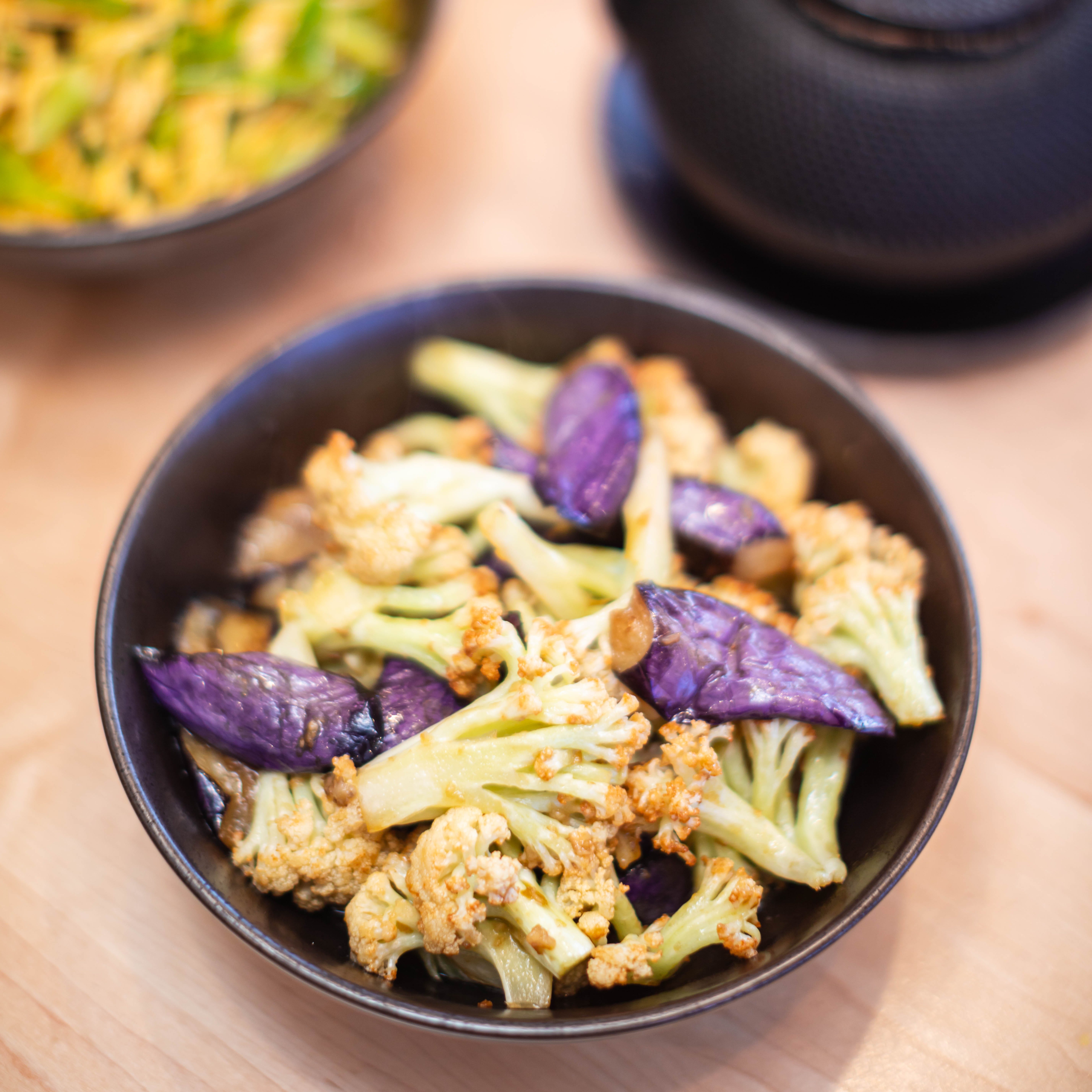
ONG: I think you can see the difference in the cauliflower more, even more so in this steamed stir-fry version, that it’s a little bit different, with more stem.
DUNLOP: Yeah, a mild dish, and with that beautiful purple Chinese eggplant.
CHANG: We call it garden duo. Again, from Grandmother’s garden.
ONG: Two vegetables.
CHANG: Do you want to know what creates the consistency?
FRIEDMAN: Yes. What’s in the sauce?
CHANG: Oil.
[laughter]
CHANG: Sorry to tell you, but —
ONG: Yeah. Globally, eggplant — always a lot of oil. From eggplant Parmesan to Chinese cooking, it’s pretty much soaked up in that. It’s pretty amazing.
CHANG: But that creates the meaty texture. It’s very tender. It’s like eating pork belly.
ONG: Recently, I just came back from Shanghai, and I went to a restaurant that you have written about, Yu Zhi Lan. How did you come about meeting Chef Lan?
DUNLOP: Well, I’ve known him for 15 or 20 years. He’s actually one of the chefs that I brought to the CIA, Culinary Institute of America, in, I think, 2004. I came with him and two other leading Sichuanese chefs to do a demonstration there. He’s always been an extremely creative and talented chef. He’s one of the most outstanding chefs of his generation, so I followed his career with interest.
When I first met him, he had a restaurant serving more farmhouse food, called 乡厨子, The Village Chef. This was all the hearty, spicy Jia Chang Cai 家常菜 home-style flavors, really. But he had this dream to open a very fine restaurant doing his own style of high-level cuisine.
So Yu Zhi Lan — I can’t remember which year it opened, but what he’s trying to do is to recreate the ambience of an old Mandarin’s house. A lot of the finest food in China was in the private dining rooms of Chinese officials who would have private chefs. I think there’s a maximum of about 18 seats in that restaurant.
ONG: Yes.
DUNLOP: It’s tiny, and it’s run by Chef Lan and his wife and his sister-in-law and a few other staff. It’s typical of Sichuanese banquet cuisine in that you have some of the spicy flavors of folk cooking, but you also have very delicate flavors based on exquisite stocks made from chicken and ham or fish, depending on the dish.
So I think you can also see that he has some very traditional dishes. Like you might get some Ma La Niu Rou 牛肉, numbing hot beef, as a starter, or a spicy rabbit dish. Very traditional. But then he becomes extremely inventive.
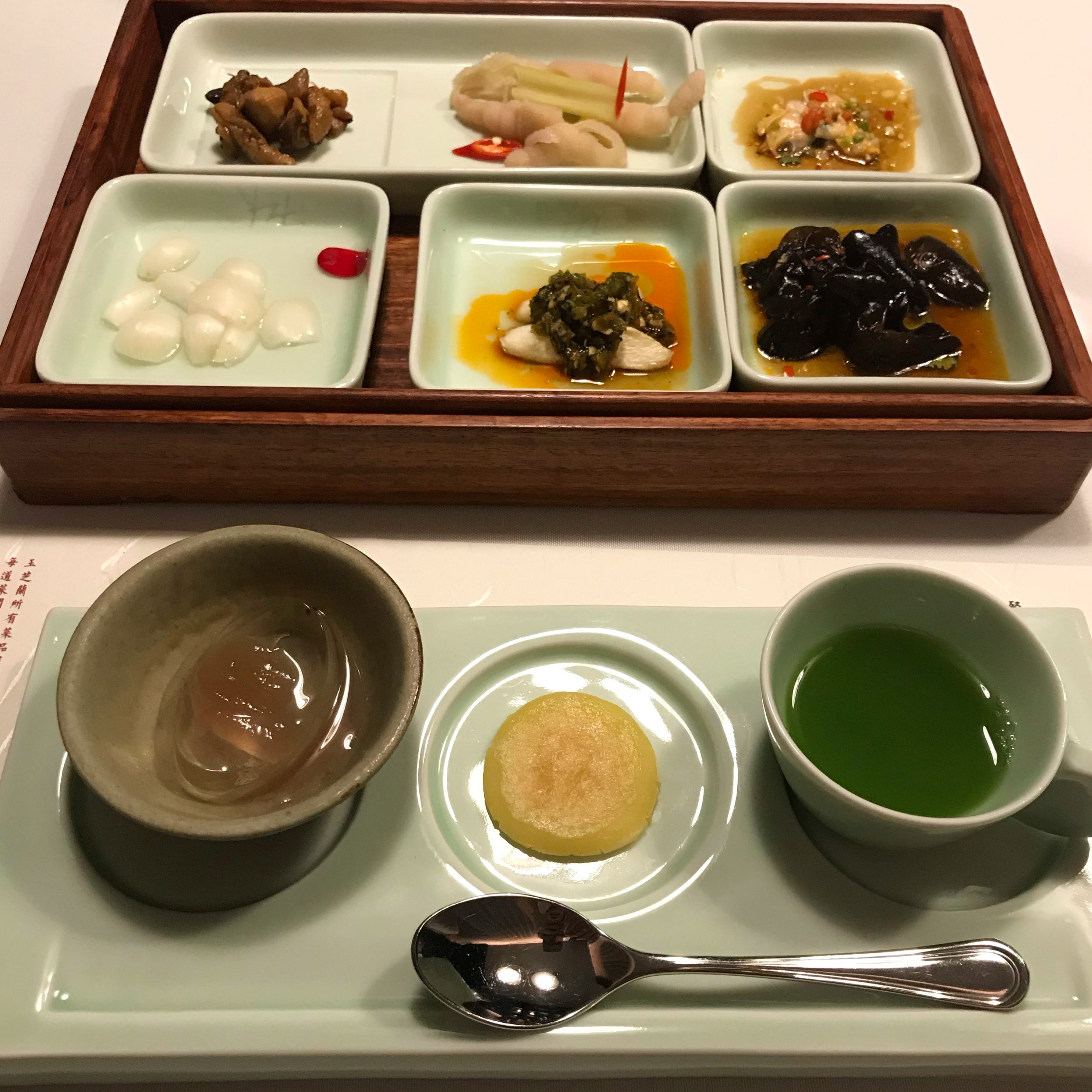
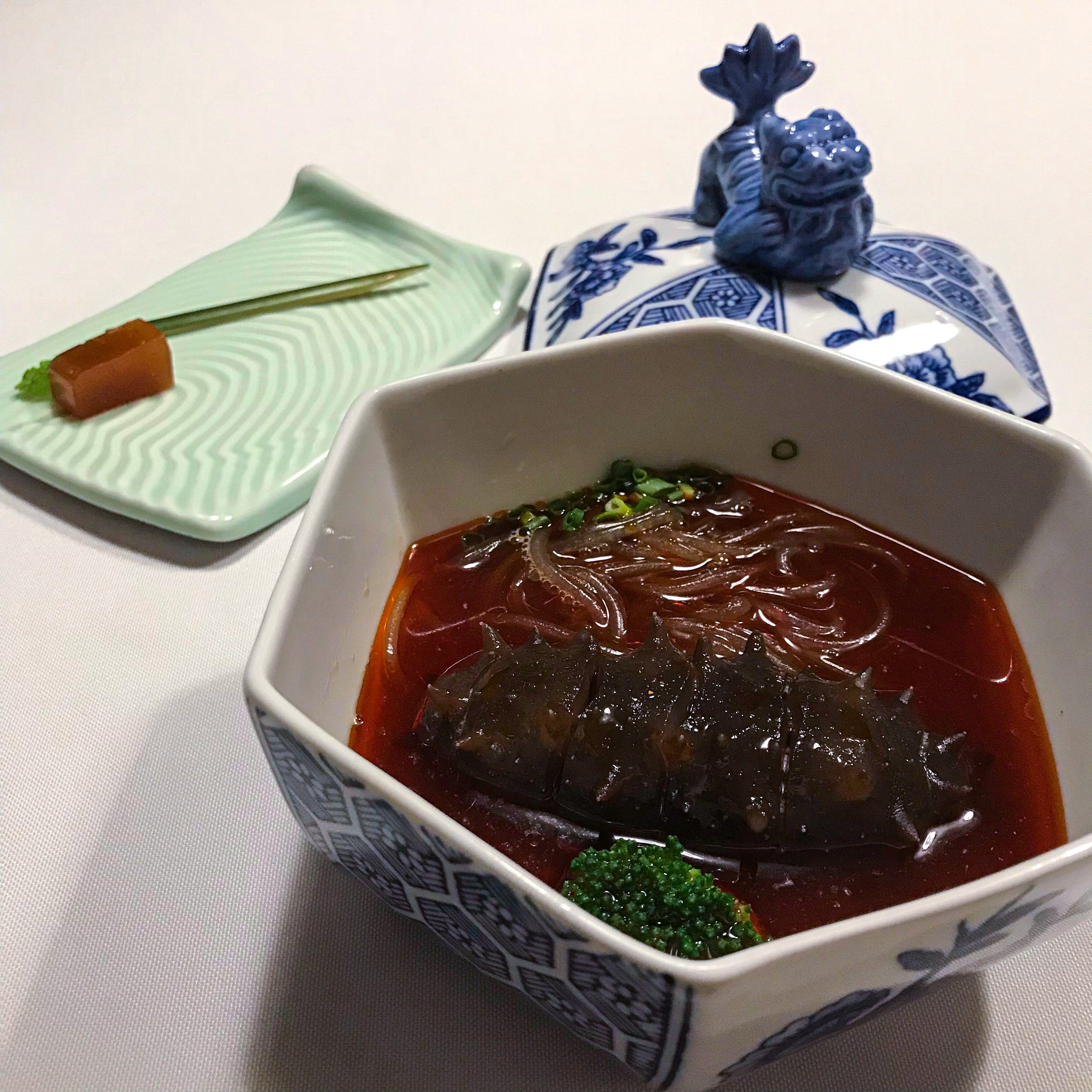
And he also designs all his own tablewares, which are handmade in Jingdezhen, the porcelain capital. So it’s quite an experience and very different from the kind of restaurants, Tyler, that you write about.
T. COWEN: Yes.
DUNLOP: Sort of holes in the wall and popular places.
[laughter]
ONG: It was high-end. But I was most impressed when I had a little tour of the kitchen, and there was only one wok, like a portable wok. I’m an okay Chinese cook, and I always tell people my weakness, especially Lydia’s dad, that I can’t wok. If you want me to cook with you, you’re doing everything on the wok. I’m just going to fry and do the salads, do the steaming, the dim sum. I can do any of that, but not the wok.
So when I saw the kitchen of Yu Zhi Lan, I was very impressed because I always have been thinking, is it possible to do a Chinese restaurant that’s not wok-focused? If you see the woks here — he’s got about 10, 12?
CHANG: Around.
ONG: Yeah. I wouldn’t be able to handle a kitchen like that, but I think that this new no-wok or less-wok Chinese restaurant — I never figured how they do that. Like in New York, there’s a very popular one called Hao Noodle by Madam Zhu.
DUNLOP: Oh, yes. Beautiful place.
ONG: And this is all over China, and there’s no wok. It’s very interesting.
DUNLOP: Really?
ONG: Yes. I think you can’t tell from the menu, but you definitely can go through, eat quite an exquisite meal, without realizing that nothing comes from the wok.
DUNLOP: I would say that when people think about Chinese cuisine, they often think about stir-fry as the Chinese method par excellence. But it’s one of many different cooking methods, and certainly steaming has been done in China since the Neolithic Age. You can say that is the classic Chinese cooking method, really.
But often, a good meal will have steamed dishes and boiled dishes as well as stir-fries, and also, particularly in Sichuan, wonderful cold dishes. Cold dressed meats and cooked salads. So yes, it’s not all about wok cookery.
T. COWEN: Given your background in Singapore, how do you assess Chinese food in Singapore? What’s it good at? What’s it not good at?
ONG: In the last century, if you speak to a lot of Chinese who migrated to, let’s say, Thailand, Vietnam, Malaysia, Singapore, the cream of the crop went to Singapore, and they mostly went before the war broke out, during famine times of the rest of China.
I find Singapore Chinese food, at the core, to be Cantonese based, I would say, for the longest time. Over time, it’s been infused with Malaysian influence, some Western, some Thai and Indian. So you find a lot of spices. You find a lot of fermented flavors, curries, and a heavier use of cinnamon, clove, star anise, which is used in Cantonese cooking, but not quite bold. We grew up with a lot of that, and it’s different. It’s in its own category altogether, wouldn’t you say?
DUNLOP: Yeah.
T. COWEN: But I’ve found I can’t get very good Sichuan food in Singapore, or at least I don’t know how to find it. That southern Chinese — Hokkien, Fujian — it’s weird, but it’s pretty good. Singaporean food is amazing. Malay food is amazing. But a lot of the harder-core Chinese regions . . . Somehow, Singapore has too many other good things for Singaporeans to be interested in them. Or do you have a different impression?
ONG: Well, to clarify a little bit more, there’s restaurant Chinese food and there’s home Chinese food. The home Chinese food might even be more simple, probably a lot of Hokkien or Teochew kind of flavors, which has a lot of soups and clear broths, and almost no stir-fry and very little oil used in the cooking, and it’s lean cuts of meat. Restaurant tends to be spicier.
But I would say that Sichuan is . . . For some strange reason, for me, in Asia it has taken a slower growth, especially in Thailand, where you almost never see Sichuan restaurant. It’s ironic because you mentioned the complexity of the flavor profile, and I agree with you. But in Thailand, for some reason you just don’t find a whole lot of Sichuan restaurants, and the same thing in Singapore. I would say that you’d probably find more in Hong Kong and the rest of China, which is a huge feat.
DUNLOP: Well, I think it is the story of immigrants.
ONG: Yes.
DUNLOP: The immigrants in Thailand — a lot of them were Teochew or Chaozhou people.
ONG: Right.
DUNLOP: And Cantonese immigrants in southeast . . . Yeah, and Hakka and Fujian. That’s a completely different flavor profile. Then in Thailand, they have their own spicy food, so maybe they don’t need Sichuanese in the same way.
ONG: Right. There’s something also about the mentality, too, of culture because I think spices for a lot of southeast Asians are seen as almost like — not as high as Cantonese because you do have to consume it with some kind of starch or rice. A lot of Singaporean Chinese or Thai Chinese — they prefer to eat more things like that, or the vegetable, for sure, where you don’t need rice, and it becomes more of a lighter meal and something that maybe on a society level is considered more of the way to eat.
DUNLOP: That’s really interesting.
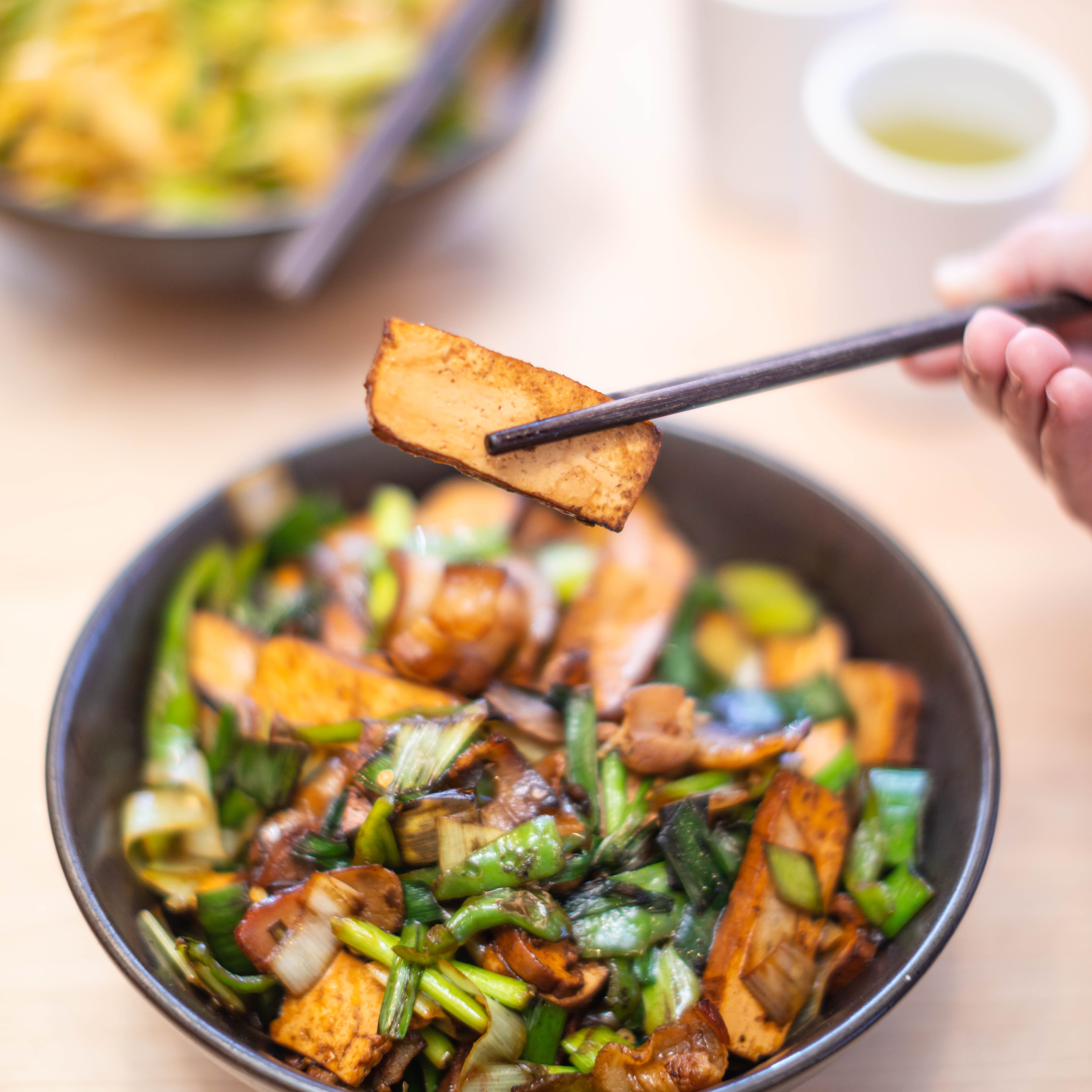
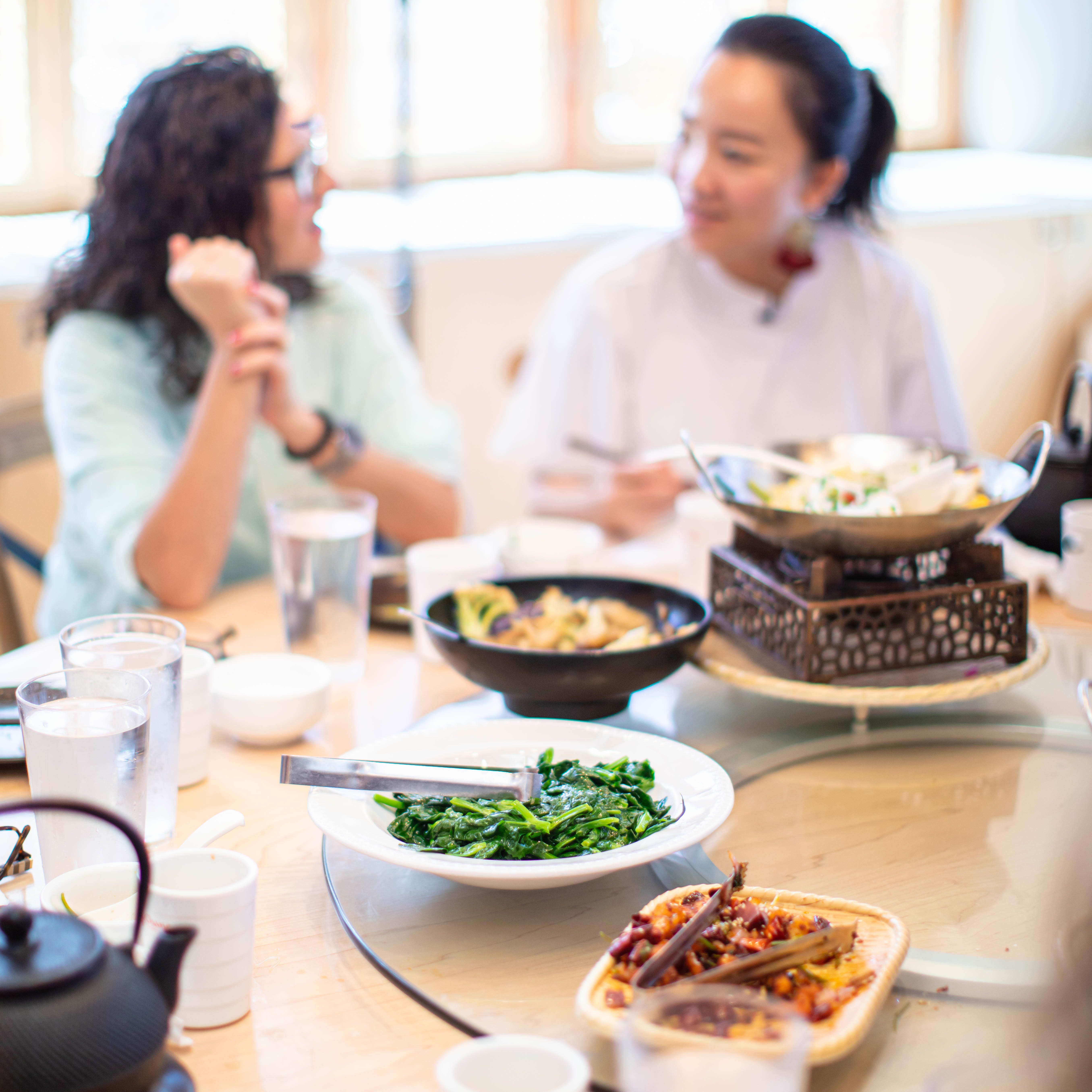
DUNLOP: And this one, this is tofu Dou Fu Gan 豆腐干, is it?
CHANG: Yeah.
DUNLOP: Pressed tofu.
CHANG: La Rou.
DUNLOP: Really?
CHANG: La Rou Chao Xiang Gan 腊肉炒香干.
DUNLOP: Oh, this is lovely.
T. COWEN: What’s the significance of that?
CHANG: We use cured pork belly we smoke in-house with some leeks, smoked tofu.
T. COWEN: And the greens have come out. Tell us about the greens, please.
CHANG: When we see the greens, we know this is the last dish of the meal. Snow pea tips, simple stir-fry.
DUNLOP: This is like also in Hunan farmhouse cooking: a little bit of cured pork with tofu, also with that smoky flavor, and the Chinese garlic or leek.
CHANG: Yeah.
DUNLOP: Delicious.
CHANG: That’s something also about Chinese food. It needs to be consumed at the hottest point temperature-wise. Going back to the Yu Zhi Lan story, yes, there are cold dishes. There are courses it’s okay to have at room temperature. But generally, Chinese food is not the best for a tasting menu because everything needs to be consumed super, super hot.
I haven’t really . . . Have you seen anything that really worked out in terms of Chinese tasting menu? Or for Sichuan?
DUNLOP: I think that the food at Yu Zhi Lan and also Yu Bo’s restaurant are fantastic, but as you said, there’s actually less of an emphasis on stir-fries, so you don’t get a big, piping-hot stir-fry dish. And more soupy dishes and braises and so on. So, yeah.
But I think one of the reasons that some Chinese chefs are now going for tasting menus is partly with an eye to international recognition, actually, and wanting each dish to be presented beautifully and not on a shared dish that gets mussed up as it’s passed around the table.
ONG: Is it similar to a Michelin Guide, but coming into China? Maybe a lot of those restaurants follow the format, basically, I think, or the style.
DUNLOP: Yeah, and I think that’s unfortunate —
ONG: It is.
DUNLOP: — that Michelin, as I mentioned before, is not very well equipped to judge Chinese food. The first Chinese restaurant to win three Michelin stars was one in a fancy hotel in Hong Kong that did a tasting menu of courses which one person could enjoy.
But I think chefs in China — as they become more internationally minded, they do feel a bit hard done by. They have this great cuisine, and why is it not recognized? Why is it not put on a par with Japanese, for example, that people are willing to spend money on?
So some chefs are definitely — I wouldn’t say at all changing the cooking technique or style, but just a bit the presentation, and aiming at that market of elite international cooking.
ONG: I appreciate that kind of restaurant too, because I do often travel by myself, and I can actually go to Yu Zhi Lan and eat at the bar by myself and enjoy a myriad of dishes with so much technique solo, and not have to eat 10 sea cucumbers at one time, [laughs] but rather just one perfect one.
DUNLOP: Yeah, so you could be a Michelin inspector.
[laughter]
ONG: I may be. I’m kidding.
[laughter]
CHERNYAK: You talked about how you think about preparing food if you’re having people over for a Chinese meal. Can you just walk us through? If you were creating the balanced meal, what are the pieces that you want to hit? You mentioned soup already, but —
DUNLOP: Well, the first thing is that if I’m cooking at home, I don’t want to be like a banshee over the stove for the whole evening, so I would not choose a menu that’s all last-minute stir-fried dishes — particularly important cooking at home. So I would always do a spread of cold dishes. How many depends on my energy level and how many people. But maybe at least three or four cold dishes. They’re easy to prepare in advance, and really delicious, and people can start eating them while you prepare the other dishes.
I would also do a slow-cooked stew, like some red braised pork or beef. Really delicious. And then I normally do mapo tofu, just because it’s one of the greatest dishes in the world and everyone loves it, and it’s very easy to make. That’s a strong dish, so I would also always have a lightly stir-fried vegetable.
Then another dish that I often do is a steamed fish, Cantonese style. It’s so easy to make, and I almost feel embarrassed that it wins so much praise. There’s something about that method — a really fresh fish, and you just marinate it, a bit of Shaoxing wine, ginger, and scallion, steam it, strew over some slivered ginger and scallion, sizzle over some hot oil, and then baste it in a little soy sauce. And that’s it. And it’s so easy, and it’s sublime. And that’s a nice contrast to the hotter Sichuanese dishes.
And I would try and get a balance between dry dishes and soupy ones, so you have different mouthfeels, different shapes. If the meat is in big, thick cubes, I might have a stir-fry that’s slivered. It’s not very scientific, but it’s impressionistic. I just try and think about how these things will taste in sequence and in relation to one another, and how they will look on the table.
In China, you don’t normally have a separate dessert course. You normally have fruit, so either cut fruit — I try and get some Chinese fruit, seasonal, maybe tangerines in winter, maybe dragons’ eyes or lychee in another season. Then because my guests may be Western and need a sugar hit, I sometimes buy in some little baklavas or chocolates to serve with the fruit, and some nice Chinese tea.
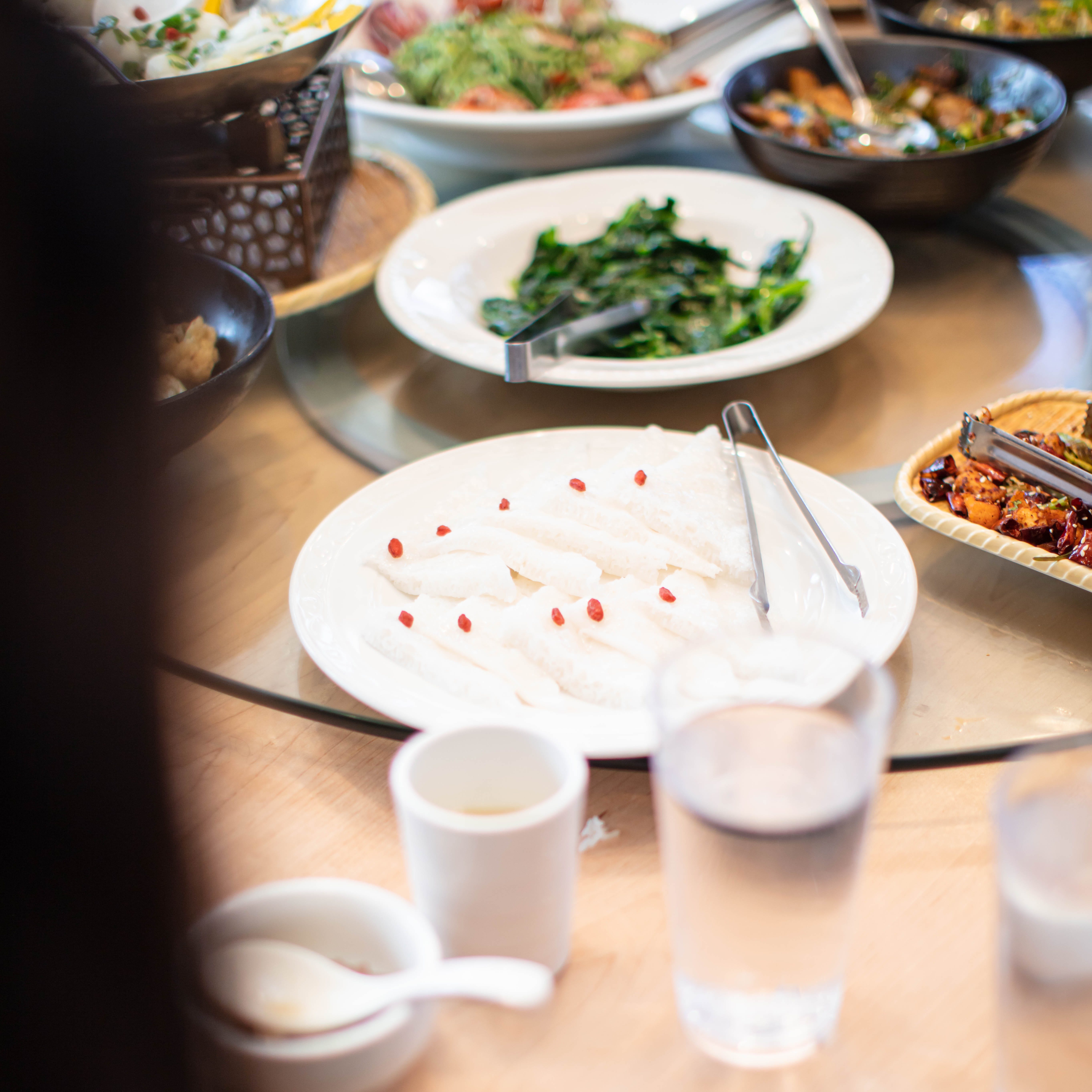
CHANG: Or sometimes it’s a rice cake. For example, we’re going to have in a minute Wai Po Mi Liang Gao 外婆米凉糕. It’s fermented rice cake, which is this white, a little translucent.
COWEN: How do you think more generally about serving Chinese final course, or I may call it dessert, in America, where Americans expect big heapings of pie and sweetness and sugar? How do you approach that? What do you pick? What do you recommend?
CHANG: We actually do have a sesame flourless chocolate cake on the menu right now, being made by Pichet, and also matcha cream cheese —
ONG: Souffle cheesecake.
CHANG: Souffle cheesecake. Those are things that’s not so . . . After a big meal like this today, there’s just hardly any room left for a . . . Yes, you always have a separate stomach for dessert, but —
[laughter]
DUNLOP: Yeah, I’m very much in favor, if you want to have a sweet hit, it doesn’t have to be Chinese, right?
CHANG: Right.
DUNLOP: If you want to have a sweet, have a chocolate cake.
ONG: Right. That’s right. For a long time, the fine-dining Chinese restaurants in the US — you’d just get a chocolate mousse cake or —
FRIEDMAN: Or a croissant.
ONG: Or crème brûlée. But with my Shanghainese mother and heritage, I do have a very, very, very sweet palate. I grew up eating chocolates for breakfast.
GANS: What other cuisines do you really like to cook? Do you have a secondary . . . If this is your major, what’s your minor?
T. COWEN: Hunan.
[laughter]
DUNLOP: Basically, other Chinese cuisines. I mainly cook Chinese food, yeah.
GANS: All the time?
CHERNYAK: Even at home?
DUNLOP: Yeah, that’s what I instinctively do. That’s my comfort food now, and that’s the easy thing to rustle up. I do do a bit of Italian — I really love Marcella Hazan’s books — and a bit of Turkish. I spent some time in Turkey when I was much younger.
But the thing is, when I have guests, they want me to cook Chinese food. Then that’s what I like eating as well.
HAGEDORN: I certainly hope they don’t want you to make Yorkshire pudding and bangers.
DUNLOP: No, and I don’t know how to make Yorkshire pudding.
T. COWEN: How do you experience the oppression of being famous at cooking? What’s the major disadvantage of that? Is it that you always feel obliged to be pleasing other people if there’s a meal? Or can you just set that out of your mind and make other people cook?
DUNLOP: Yeah. When I published my first book, suddenly my friends started saying, “We’re scared to cook for you.” And that’s a shame because it’s lovely being cooked for, and you don’t have to be a professional cook.
But the funny thing was that after my first book was published, I had a total cooking paralysis at home for ages. I was too scared to cook for people because I thought everyone was going to be thinking, “Oh, she’s a professional cookbook writer. It’s got to be really good.” And I would only disappoint them. Now I don’t care anymore.
But the great advantage about writing about food, particularly Chinese food, is that I do get invited out for the most wonderful meals in China, and I feel so privileged.
T. COWEN: On that note, why don’t we end the podcast formally? I’d just like to thank Fuchsia and again recommend heartily her new book, The Food of Sichuan. What I find most remarkable in her books . . . As somebody who writes books and reviews many books — most books, there are just pages, pages where the author is coasting. What’s there might be fine. It might be true. But there’s parts that are really good, and then parts like, “Yeah, yeah, yeah.”
In Fuchsia’s books, there is no page, there is no paragraph, there’s no word that’s coasting. It’s all as great as the best parts, and to me that’s a phenomenal achievement, just in terms of the production function of Fuchsia Dunlop. Whether or not Chinese food is your thing, they’re just marvels of books to read, to understand books.
And to thank Lydia and her family and all of the people in the kitchen, all of those serving us. Lydia, this was a remarkable meal. I’ll repeat again: Mama Chang is one of my favorite restaurants on planet Earth. I come here many, many times. I’ll of course see you and all the others again, and this was just phenomenal.
And to all of our distinguished guests, thank you for coming, your remarks, and so on. Let’s just have a round of applause for Fuchsia and Lydia.
CHANG: Thank you.
DUNLOP: Thank you. Wonderful food, Lydia.